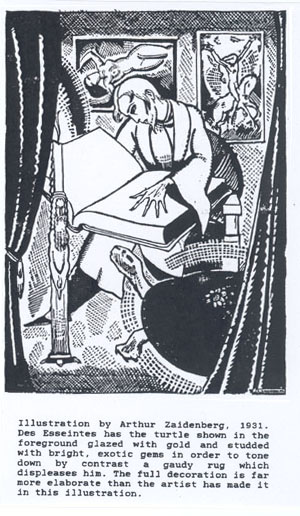PHIL 332, Philosophy of Beauty, Additions
Contents
1.
Descriptions of beauties and of the effect of beauty
1.
Salman Rushdie, Fury, excerpt
2.
John Ruskin describing a day high in
the Alps
3.
Dylan Thomas, "Poem in
October," excerpt
4.
Jean Dubuffet on things
traditionally despised as "unaesthetic": Empreintes.
5.
Sarah Hubbell on the beauty of
insects
6.
The Japanese Wabi-sabi
aesthetic
7.
A consolingly beautiful feature in a
corpulent, aged body
8.
A truly beautiful state of mind:
Patrick Leigh Fermor
2.
The Neoplatonic
impulse to ascend to Beauty Itself as inherent to aesthetic experience and Kirwan's phenomenological version of this.
3.
James Kirwan's
idea of a Neoplatonic-like yearning lying within our
experience of beauty
4.
Mathematical beauty in art forms:
images and texts from Ivar Peterson, Fragments of
Infinity.
5.
Kenneth Chang, "What makes an
equation beautiful." NY Times, 10/24/04.
6.
Jonathan Swift on the Laputans' obsession with mathematically regular forms, from
Gulliver's Travels, 1729.
7.
Hutcheson's application of the
uniformity and variety criterion to geometry and astronomy
8.
Modes of Apollonian and Dionysian
architecture
1.
Classical Greek temples
2.
Gothic and Hindu temples
3.
Cool modernism: I. M. Pei's National
Gallery East wing.
4.
Post-modernist free-flow
architecture: Frank Gehry Guggenheim Bilbao
9.
Other illustrations re. Apollonian
vs. Dionysian beauty
10. Scent and
flavor as an art form: Karl Joris Huysmans' decadent
aesthete, Des Esseintes.
11. Properties
of scent
1.
Odor descriptions of fragrant oils
2.
Odor classification
3.
A code for smell
4.
Creative development of perfumes of
a given type
5.
The Malororous
garden
12. Psychological
investigation into the common properties of faces widely judged beautiful, the
connection between beauty and evolutionary survival, etc.
1.
Beauty and the beholder, Nature,
3/17/94
2.
Facial beauty and the golden
section: the Marquardt beauty mask
13. Mate choice
as influencing human development: Geoffrey F. Miller (1998)
14. Variations
in ideals of the human body
15. Jonathan
Swift on the Houyhnhnms, from Gullivers'
Travels (1729)
16. Edward Bullough, "Psychical Distance as a Factor in Art and
an Aesthetic Principle," excerpt.
17. Munsell Color Solid
18. Beautiful
regularity and appearances of regularity/irregularity. Temple of Poseidon at
Paestum and three modifications. Homework exercise.
a. Perception of
differences
b. Aesthetic appreciation
of differences
19. An
unbreakable visual illusion
20. Great chain
of being illustration.
21. The
aesthetic character of athletic mastery
22. Amazing
pendulum movements.
23. George
Bernard Shaw on the pleasures of heaven and hell, Man and Superman, Act
III.
*****************************************
1. Descriptions of beauties and of the
effect of beauty.
1.1. Salman Rushdie, Fury (2002) describes the effect of a beautiful young woman of
mixed Polynesian and Indian parentage. The protagonist of the novel, himself
dazzled from an earlier meeting at her boyfriend's apartment, meets her on the
steps of the Metropolitan Museum of Art on Fifth Avenue. They sit for a while
and then start walking on Fifth Avenue.
Neela was wearing a knee-length mustard-colored scarf dress in silk. Her black hair was twisted up into a tight chignon and her long arms were bare. A cab stopped and expelled its passenger just in case she needed a ride, A hot dog vender offered her anything she wanted, free of charge. "just eat it here, lady, so I can watch you do it." ...Solanka felt as if he were escorting one of the Met's more important possessions down an awestruck Fifth Avenue. No: the masterpiece he was thinking of was at the Louvre. With a light breeze flowing the dress against her body, she looked like the Winged Victory of Samothraki, only with the head on... (147)
They walk into Central Park:
They sat on a bench near the pond, and all around them dog walkers were colliding with trees, Tai Chi practitioners lost their balance, rollerbladers smashed into one another, and people out strolling just walked right into the pond as if they'd forgotten it was there. Neela Mahendra gave no sign of noticing any of this. A man walded past with an ice cream cone, which, owing to his sudden but comprehensive loss of hand-to-mouth coordination, completely missed his tongue and instead made contact, messily, with his ear. Another young fellow began, with every appearance of genuine emotion, to weep copiously as he jogged by...(149)
Much later she talks about herself. (204-5)
She spoke of her beauty as something a little separate from herself. It had simply "shown up." It wasn't the result of anything she'd done. She took no credit for it, was grateful for the gift she'd been given, took great care of it, but mostly thought of herself as a disembodied entity living behind the eyes of this extraordinary alien, her body: looking out through its large eyes, manipulating its long limbs, not quite able to believe her luck. Her impact on her surroundings — the fallen window cleaners sitting splay-legged on various sidewalks with buckets on their heads, the skidding cars, the danger to cleaver-wielding butchers when she stopped for meat – was a phenomenon of whose results, for all her apparent unconcern, she was sharply, precisely aware. She could control "the effect" to some degree...she could intensify the world's response to her by making fine-tuning adjustments to her stride length, the tilt of her chin, her mouth, her voice. At maximum intensity she threatened to reduce entire precincts to disaster zones.
1.2. John Ruskin describing a day high in
the Alps
From Modern Painters (1873), Vol.
1, Section III, Chapter IV, "Of Truth of Clouds," ##35-37.
Ruskin's purpose is to contrast clouds as
they really are with the poor efforts of traditional painters, and to describe
how superior the clouds in J.M.Turner's works are,
but I have deleted references of this sort. All that matters for our purposes
are the description Ruskin gives and the manifest effect the beauties he
witnesses have on him.
§ 35. Morning on the plains
...Stand upon the peak of some isolated mountain at daybreak, when the night mists first rise from off the plains, and watch their white and lake-like fields as they float in level bays and winding gulfs about the islanded summits of the lower hills, untouched yet by more than dawn, colder and more quiet than a windless sea under the moon of midnight; watch when the first sunbeam is sent upon the silver channels, how the foam of their undulating surface parts and passes away; and down, under their depths, the glittering city and green pasture lie like Atlantis, between the white paths of winding rivers; the flakes of light falling every moment faster and broader among the starry spires, as the wreathed surges break and vanish above them, and the confused crests and ridges of the dark hills shorten their gray shadows upon the plain...
§ 36. Noon with
gathering storms.
Wait a little longer, and you shall see those scattered mists rallying in the ravines, and floating up toward you, along the winding valleys, till they couch in quiet masses, iridescent with the morning light,* upon the broad breasts of the higher hills, whose leagues of massy undulation will melt back and back into that robe of material light, until they fade away, lost in its lustre, to appear again above, in the serene heaven, like a wild, bright, impossible dream, foundationless and inaccessible, their very bases vanishing in the unsubstantial and mocking blue of the deep lake below...Wait yet a little longer, and you shall see those mists gather themselves into white towers, and stand like fortresses along the promontories, massy and motionless, only piled with every instant higher and higher into the sky, and casting longer shadows athwart the rocks; and out of the pale blue of the horizon you will see forming and advancing a troop of narrow, dark, pointed vapors, which will cover the sky, inch by inch, with their gray network, and take the light off the landscape with an eclipse which will stop the singing of the birds and the motion of the leaves together; and then you will see horizontal bars of black shadow forming under them, and lurid wreaths create themselves, you know not how, along the shoulders of the hills; you never see them form, but when you look back to a place which was clear an instant ago, there is a cloud on it, hanging by the precipices, as a hawk pauses over his prey...And then you will hear the sudden rush of the awakened wind, and you will see those watch-towers of vapor swept away from their foundations, and waving curtains of opaque rain let down to the valleys, swinging from the burdened clouds in black, bending fringes, or pacing in pale columns along the lake level, grazing its surface into foam as they go.
§ 37. Sunset in tempest.
Serene midnight.
And then; as the sun sinks, you shall see the storm drift for an instant from off the hills, leaving their broad sides smoking, and loaded yet with snow-white torn, steam-like rags of capricious vapor, now gone, now gathered again; while the smouldering sun, seeming not far away, but burning like a red-hot ball beside you, and as if you could reach it, plunges through the rushing wind and rolling cloud with headlong fall, as if it meant to rise no more, dyeing all the air about it with blood... And then you shall hear the fainting tempest die in the hollow of the night, and you shall see a green halo kindling on the summit of the eastern hills, brighter -- brighter yet, till the large white circle of the slow moon is lifted up among the barred clouds, step by step, line by line; star after star she quenches with her kindling light, setting in their stead an army of pale, penetrable, fleecy wreaths in the heaven, to give light upon the earth, which move together, hand in hand, company by company, troop by troop, so measured in their unity of motion, that the whole heaven seems to roll with them, and the earth to reel under them...
§ 38. And sunrise on the Alps
And then wait yet for one hour, until the east again becomes purple,* and the heaving mountains, rolling against it in darkness, like waves of a wild sea, are drowned one by one in the glory of its burning; watch the white glaciers blaze in their winding paths about the mountains, like mighty serpents with scales of fire; watch the columnar peaks of solitary snow, kindling downwards, chasm by chasm, each in itself a new morning; their long avalanches cast down in keen streams brighter than the lightning, sending each his tribute of driven snow, like altar-smoke, up to the heaven; the rose-light of their silent domes flushing that heaven about them and above them, piercing with purer light through its purple lines of lifted cloud, casting a new glory on every wreath as it passes by, until the whole heaven -- one scarlet canopy, -- is interwoven with a roof of waving flame, and tossing, vault beyond vault, as with the drifted wings of many companies of angels; ...
* I have often seen the white, thin, morning cloud, edged with the seven colors of the prism. I am not aware of the cause of this phenomenon, for it takes place not when we stand with our backs to the sun, but in clouds near the sun itself, irregularly and over indefinite spaces, sometimes taking place in the body of the cloud. The colors are distinct and vivid, but have a kind of metallic lustre upon them.
1.3. An example of succinct but intense
beauty-description
Dylan Thomas, "Poem in October,"
excerpt.
The poet walks out early on his 30th birthday
from his Welsh village by the sea into the country: "I walked abroad in a
shower of all my days".
..........................................
A springful of larks in a rolling
Cloud and the roadside bushes brimming with whistling
Blackbirds and the sun of October
Summery
On the hill's shoulder,
Here were fond climates and sweet singers suddenly
Come in the morning where I wandered and listened
To the rain wringing
Wind blow cold
In the wood faraway under me.
Pale rain over the dwindling harbour
And over the sea wet church the size of a snail
With its horns through mist and the castle
Brown as owls
But all the gardens
Of spring and summer were blooming in the tall tales
Beyond the border and under the lark full cloud
There could I marvel
My birthday
Away...
1.4. An off-beat appreciation of usually
disregarded aesthetic objects
The French painter and sculptor Jean
Dubuffet (b. 1901) writes rapturously of things that traditionally were
despised as highly "unaesthetic."
(From Empreintes, 1957;
excerpted from Herschell Chipp,
Theories of Modern Art, 1968.)
I like to proclaim that my art is an attempt to bring all disparaged values into the limelight. Also, I am more curious about these elements than about all the others, because they are so prevalent as to be always in sight. The voices of dust, the soul of dust, interest me a great deal more than the flower, the tree, or the horse, for I have a feeling that they are more extraordinary. Dust is a being so different from us. Just that absence of defined form ... one might want to change into a tree, but to change into dust-- into such a continuous existence -- would be so much more tempting. What an experience! What information!
Dubuffet admits to 'a fascination with
untouched traces,' and declares himself to be 'in all spheres, smitten with
savagery.'
Would you rather, reader, friend, that I traveled, that I took you to absurd countries, led you before mosques, pagodas, Persian markets, tropical rivers, coral reefs. Kindly think seriously about the inanity of dimension. It is a mad prejudice, a vulgar trap, which makes you marvel at your snowcapped peaks, high cliffs, your gardens of rare species, or your elegant islands. Burn scale! Look at what lies at your feet! A crack in the ground, sparkling gravel, a tuft of grass, some crushed debris, offer equally worthy subjects for your applause and admiration. Better! For what is more important is not reaching objects of reputed beauty after long days of travel, but learning that, without having to move an inch, no matter where you are, all that first seemed most sterile and mute is swarming with facts which can entrance you even more. The world does not extend over one single plane, all on the surface. The world is made in layers, it is a layer cake. Probe its depths, without going any further than where you stand, you will see! I am speaking figuratively, you understand.
The probing, Dubuffet explains, requires a
special intensity:
But take care, this is a venture in which a certain spiritual position in the operator is more necessary than anything else; this is an operation whose success is dependent above all upon a certain forcing of the thoughts, a certain over-excitement which augments conduction, facilitates the transformation of one order of ideas into another, makes all parts of the mind permeable, so that currents can pass without restriction. Therefore, please allow me my grasses and tufts of weeds, allow me my common plants which, by their very commonness, exercise a stimulating effect on my spirit. Heat, a high spritual temperature, is needed in my business.
The veil obscuring the real character of
things falls away only when the observer achieves a self-forgetful state of
naturalness or spontaneity:
Plants or people, or everything existing, each has a mask all ready with which to reply to tiresome inquiries, and it is only by this mask that we usually know them. The truth is that no one wants to be looked at; each one, the instant he senses a stare, and before having been touched by it, pulls the painted curtain. The indiscreet always get caught! Return with their painted curtains thinking that they have something -- having seen nothing, suspected nothing of the real creatures behind them. You must have savoir faire to unveil the creature and have it dance in your presence, forgetting that it is watched. For everyone dances and does nothing but dance; living and dancing are one and the same thing; indeed each thing is finally no more than a specific dance; the dance is the thing. Dancing is the subtle word for living, and it is only by dancing too that one can discover anything. One must approach dancing. He who has not understood that will never know anything about anything. All the faults dance badly -- dance stiffly, too laboriously, watch themselves dance, do not forget that they are dancing. He who dances will not endure a stare, especially his own. Socrates, the point is not to know, but to forget, oneself....
Dubuffet's orientation toward the unbeautified natural phenomenon goes hand in hand with a
curious impression which he himself seems to concede lacks any rational
foundation.
I will permit myself to add, parenthetically, that I am perhaps more sensitive than just anyone to phenomena from which the intervention of the human hand has been totally eliminated, because of a certain temperamental disposition peculiar to me, which leads me to attribute, contrary to popular opinion, less intelligence, less knowledge, less power, to the human being than to other beings of the natural world, and indeed to those which are rather more often considered out of the question in this sphere, such as plants or stones. I can not rid myself of the constant impression that consciousness -- that endowment of which man is so proud -- dilutes, adulterates, impoverishes, as soon as it intervenes; and I feel most confident when it does not seem to be present.
A closely associated idea, of slightly higher
standing in the history of natural philosophy, is that of the animate, indeed
psychic, character of all natural objects -- which Dubuffet is quite ready to
extend to momentary states of things (a wave, a shadow, a gesture)!
No one contests the breath of life is found in minerals as well as plants or animals, and whoever hesitates at that has only to think of the polyhedric crystal, which aspires with all its will to form, and finally does form, the rock. At this point, we are quite easily led to expand our idea of what is embraced by the term being -- although not without a slight hesitation -- to certain elements, no longer isolated and with well-defined contours, like the leaf of a tree or the crystal, but continuous and having neither form nor limited quality, such as coal, metal, water. But what of the momentary and moving, of the wave which forms for an instant in the great open sea; is it a being? If a will -- no matter how obscure, how vacillating -- appears in any part of the inert mass, even for a very short time, does this not suffice to make a being? Is the shadow of a walker a being like the walker himself? And the step of the walker, his walk, are they beings? Where does one begin, where does one end, in the use of the term being?
Comment
Whatever we think of Dubuffet's beliefs about
natural objects we can hardly deny that Dubuffet's experience, as described, is
aesthetic. Whether such experience has any chance of yielding knowledge of the
sort Dubuffet thinks it gives, is another matter altogether. We may also wonder
whether his delight partly depends on his belief. Perhaps dust and pebbles
would not look as beautiful to him were it not for his belief in their being
animate.
1.5. Sarah Hubbell
on the beauty of insects. From Broadsides
from the other orders: a book of bugs, 1993, pp. 138-9.
Although some people who are not familiar with them think of bugs as ugly, you can't be around entomologists for long before bug handsomeness becomes obvious. When I talked to Cassie Gibbs about black flies I asked her how it was she had specialized in mayflies, which appear to have wings made of isinglass. "They are such beautiful insects," she said forthrightly. But it was Asher [Treat] who first introduced me to bug beauties beyond normal human seeing. One day he invited me to inspect a tiny moth, undistinguished and dun-colored to the naked eye. Under the microscope it revealed itself, shimmering, gleaming, golden, decked out in mothly splendor. A goldsmith would have been impressed by its exquisiteness, and so was I. The scanning electron microscope opened up a new world of information and study for entomologists, just as it did for scienctists in other fields, but it also opened up a new world of beauty. I have a copy of A Scanning Electron Microscope Atlas of the Honey Bee,nearly 300 pages of SEM photos of bees, photos of surpassing loveliness of shape, texture, and form. I know a sculptor who uses it to give him inspiration for his work.
1.6. The Japanese Wabi-sabi
aesthetic
1. An excerpt from Wikipedia "Wabisabi"
Wabi now connotes rustic simplicity, freshness or quietness, and can be applied to both natural and human-made objects, or understated elegance. It can also refer to quirks and anomalies arising from the process of construction, which add uniqueness and elegance to the object. Sabi is beauty or serenity that comes with age, when the life of the object and its impermanence are evidenced in its patina and wear, or in any visible repairs.
From an engineering or design point of view, "wabi" may be interpreted as the imperfect quality of any object, due to inevitable limitations in design and construction/manufacture especially with respect to unpredictable or changing usage conditions; then "sabi" could be interpreted as the aspect of imperfect reliability, or limited mortality of any object, hence the etymological connection with the Japanese word sabi , to rust.
A good example of this embodiment may be seen in certain styles of Japanese pottery. In the Japanese tea ceremony , the pottery items used are often rustic and simple-looking, e.g. Hagi ware , with shapes that are not quite symmetrical, and colors or textures that appear to emphasize an unrefined or simple style. In reality, these items can be quite expensive and in fact, it is up to the knowledge and observational ability of the participant to notice and discern the hidden signs of a truly excellent design or glaze (akin to the appearance of a diamond in the rough). This may be interpreted as a kind of wabi-sabi aesthetic, further confirmed by the way the colour of glazed items is known to change over time as hot water is repeatedly poured into them ( sabi ) and the fact that tea bowls are often deliberately chipped or nicked at the bottom ( wabi ), which serves as a kind of signature of the Hagi-yaki style.
2. JB's commentary on Yuriko Saito's explanation of Wabi-Sabi
The Japanese aesthetic of imperfection and insufficiency is quite puzzling. Naturally one turns to explanations by specialists. One such is found in an article by Yuriko Saito, “The Japanese Aesthetics of Imperfection and Insufficiency,” Journal of Aesthetics and Art Criticism 55, 4 (Fall 1997) 377-385. Her purpose is to show that ugliness or imperfection can indeed be aesthetically prized. Her account has the virtue of recognizing the complexity of the factors that go into the Wabi-Sabi view of things. But problems arise in taking it as a coherent celebration of ugliness or imperfection.
(1) Some of the values cited by Saito seem not to concern the ugly but only mixed cases of mild unbeauty offset by aspects of subdued beauty. Such are worn surfaces, which may have a pleasing patina or weathered surfaces in which the grain gains saliency. We need more enlightenment as to what exactly is deemed beautiful about the worn plate and the cracked tea cup, and what would count as an exceptionally good Wabi-Sabi example. (2) At some places Saito's account suggests that the judgment exercised in the Wabi-Sabi aesthetic is skewed: it “overcompensates” for naïve and courtly love of luxury and ostentation. This appears to imply that it is invalid, that those who relish the worn surfaces overvalue them.. (3) In some cases non-aesthetic considerations seem mixed with aesthetic ones. Political expediency is said to influence the endorsement of the values; endorsing the aesthetic becomes a self-protective “gesture toward social egalitarianism” on the part of nervous nobles. (381) At another point she characterizes the aesthetic as a movement among cultural elite nostalgic for lost status and wealth. This amounts to a cryptic form of sour grapes. (4) A philosophical or spiritual version of the aesthetic is ascribed to Zen Buddhists who seek the Buddha nature “which makes no discriminations between various objects and activities.” (381f) Taken literally this won't wash as an aesthetic point of view since that necessarily distinguishes between better and worse. Rather it amounts to a principled suppression of the aesthetic point of view in favor of a spiritual one.
These and a number of other elements in Saito's account give grounds for doubting the whole qualifies as a straightforwardly aesthetic elevation of the unbeautiful over the beautiful. Its purer forms seem rather to be refined sorts of aesthetic self-denial for the sake of spiritual beauty in oneself. Perhaps the prudent ruler if candid would claim that the element of hypocrisy in his celebration of the unbeautiful is aimed at producing a beautifully even-tempered civil society. In neither case is the orientation, as described, consistently and sincerely aesthetic.
In class I will give a powerpoint segment on this aesthetic taken as such.
1.7. A consoling beauty in a mass of
aged flesh. Edith Wharton, Age of Innocence, Bk. 1, Ch. 6, describing Mrs. Manson Mingott.
The immense accretion of flesh which had descended on her in middle life like a flood of lava on a doomed city had changed her from a plump active little woman with a neatly-turned foot and ankle into something as vast and august as a natural phenomenon. She had accepted this submergence as philosophically as all her other trials, and now, in extreme old age, was rewarded by presenting to her mirror an almost unwrinkled expanse of firm pink and white flesh, in the center of which the traces of a small face survived as if awaiting excavation. A flight of smooth double chins led down to the dizzy depths of a still-snowy bosom veiled in snowy muslins that were held in place by a miniature portrait of the late Mr. Mingott; and around and below, wave after wave of black silk surged away over the edges of a capacious armchair, with two tiny white hands poised like gulls on the surface of the billows.
Needless to say the almost wrinkled expanse
of pink and white flesh that Mrs. Mingott presents to
her mirror consists only of her face and as much of her upper chest as is
decent to expose to her view. Still, such small consolations
help make human life bearable.
1.8. A truly beautiful state of mind
One of the all-time great foot-travelers and
travel writers, Patrick Leigh Fermor, who was also a
World War II hero and the master of many languages, provides a sterling example
of a beautiful state of mind in his book, A Time to Keep Silence. He
recounts his experience in 1953 in the Abbey of Saint-Wandrille
in Normandy, to which he had repaired as a visitor in order to have absolute
tranquility to write his first book. The extreme isolation imposed by the
monastic discipline – no talking to almost anyone, no contact with the outer
world, only simple food and water to drink, etc. initially brought on a state
of depression. He couldn't write. He suffered from insomnia; then a period when
he slept as if drugged, waking only for meals. He continues:
Then began an extraordinary transformation: this extreme lassitude dwindled to nothing; night shrank to five hours of light, dreamless and perfect sleep, followed by awakenings full of energy and limpid freshness. The explanation is simple enough: the desire for talk, movement and nervous expression that I had transported from Paris found, in this silent place, no response or foil, evoked no single echo; after miserably gesticulating for a while in a vacuum, it languished and finally died for lack of any stimulus or nourishment. Then the tremendous accumulation of tiredness, which must be the common property of all our contemporaries, broke loose and swamped everything. No demands, once I had emerged from that flood of sleep, were made upon my nervous energy: there were no automatic drains, such as conversation at meals, small talk, catching trains, or the hundred anxious trivialities that poison everyday life. Even the major causes of guilt and anxiety had slid away into some distant cave and not only failed to emerge in the small hours as tormentors but appeared to have lost their dragonish validity. This new dispensation left nineteen hours a day of absolute and god-like freedom. Work became easier every moment; and, when I was not working, I was either exploring the Abbey and the neighboring countryside, or reading. The Abbey became the reverse of a tomb – not, indeed, a Thelema [a potion leading to a sense of release from all inhibitions] or a Nepenthe [a potion that induces forgetfulness], but a silent university, a country house, a castle hanging in mid-air beyond the reach of ordinary troubles and vexations…
That's as close to heaven as I think we need
to get! Fermor elsewhere calls it "a state of
peace that is unthought of in the ordinary
world." This is what I meant when I said that the state of mind implied by
Kirwan's thirst for a beauty beyond beauty would not
bear comparison with a life blessed with finite but exalted states of being.
Interestingly the ethereal state enjoyed in
his best days in the Abbey gave way to acute distress immediately he returned
to the outside world: "the outer world seemed afterwards, by contrast, an
inferno of noise and vulgarity entirely populated by bounders and sluts and
crooks...From the train that took me back to Paris, even the advertisements for
Byrrh and Cinzano seen from
the window, usually such jubilant emblems of freedom and escape, had acquired
the impact of personal insults."
2. The Neoplatonic
impulse to ascend to Beauty Itself as inherent to aesthetic experience and Kirwan's phenomenological version of this.
Plotinus takes over Plato's notion of the
great chain of beauty, as it might be called, the ranking of realities from the
least to the greatest in beauty, culminating in Beauty Itself. As has already
been pointed out, there are terrific difficulties in working out the details of
such a picture. It's hard enough to imagine ranking everything in relation to
everything else even within particular domains, the animal kingdom, for
instance, let alone nature as a whole, let alone nature as opposed to culture,
etc. But it seems clear that Plato and Plotinus were not all that interested in
the details. Their eye was mainly fixed on the transcendent, off-the-scale
destination – as well as on a few big steps, such as from individuals to
properties, from physical beauties to intellectual beauties. With this
orientation, the lofty end-state of contemplating Beauty Itself (in Plotinus
the "One") trumps any experience, however impressive, of the myriad
details like the ones we have been sampling. And Plotinus makes the process of
rising up to that level sound quite wonderful, doesn't he? If only we believed
in ourselves, in our capacity to prune away the squalor and triviality in our
souls, his account of lifting ourselves up to grasp the unspeakable brilliance
of Pure Beauty would be enthralling, wouldn't it? Like the religious mystic's
account of seeing, or dwelling within the presence of, the unspeakable majesty
of God.
Actually, the accounts of experiencing the
primal realities (God, Beauty Itself) are conspicuously spare, uninformative.
Most of the descriptive content concerns the object, the remainder being how wonderful,
blissful, rewarding, breath-taking the experience is. There's nothing specific
about what that experience is like, nothing sensory or conceptual. A common
theme in all the accounts is the ineffability of the experience, which means
the impossibility of putting it into words. In this respect the mystical
experiences are quite unique. Other things called inexpressible are not really
inexpressible: love, sexual ecstasy, beauty-rapture, drug highs, and their
negative counterparts, and so forth. They just take analytic effort, sustained
noticing of features, and then semantic invention to find descriptions that
fit.
Informative or not, the Neoplatonists'
accounts are apt to seem somehow right, at least in pointing toward an ideal.
They have seemed so to countless people over the ages, so we should try to
understand their appeal. Let's see what momentum the great chain of beauty
generates and how that might lead us on to the apex. The key attribute of the
top level is that it is abstract. So if we can understand the appeal of the
abstract we will make progress. Since the process of abstraction begins at the
second level of the chain, let's concentrate on that. As we move from the
beauty of particulars to the beauty of properties, what happens? The object of the experience changes. It was a particular
face (or a particular sounding of a chord, or a particular rose). Then it is a
face-plan, a schema, a type, an arrangement of features, something abstract in
that many particulars can share it. What is involved in experiencing the beauty
of this abstract thing? It's not all that easy to say. One thing we can say it
must involve is finding each fully compliant instance beautiful, that is, each
face that complies with the face-plan. Like admiring slim legs or a slender but
curvaceous silhouette wherever it appears. Strictly this is admiring a
class of instances as opposed to a single one. To admire a class is to
admire each and every member of that class as it comes into view in the flesh
or in memory. But what is it like to admire the very idea of
that sort of face or figure? This is like relishing the thought of that
face-plan without reference to any full-fledged particulars. It's abstract in
that the mental envisagement of the plan lacks the sensory clarity and detail
of any particular face. It's an idea, not a concrete image. Platonists say that
it is purer because of its abstractness. What can this mean? Do your ideas seem
purer than your visual, that is, your perceptual images? In a way they do.
One's ideas come without any of the complications of a perceptual image. That
is, the perceptual image is of things that look different when you come up
close, whereas your ideas finesse all of that. They don't contain the
possibility of closer inspection. So it's as if all the close-up grotesqueness
is purged away, the sticky ridges on the lips, the pores and hairs and jelly in
the corners of the eyes just don't exist in the idea. The skin and everything
else seems immaculate just because all those things are lost in the
abstraction.
(Yet if the face-plan is going to be highly,
richly beautiful it's going to have to be highly specific, not just a schema
for placing the main features. All the contours must be included, so the idea
is a quite complicated one. It won't be easy to think the thought of all those
being just so. This is why designers have to depend so heavily on drawings,
that is, on their visual perception, in order to create a beautiful face-plan.
A consequence of this is that it's not easy to conjure up a really beautiful
abstraction of something as complex as a human face. More on
this in a moment in connection with Cicero's statement about the artist's
idea.)
Another way in which abstractions seem purer
is when they concern only a few features, as when the law of gravity applies to
everything that has mass but only specifies it in respect of its weight and
what follows from that, given its other characteristics. So the law seems purer
than the phenomena it governs. Does this kind of comparative purity, which
boils down to simplicity, make the law more beautiful than its instances?
This is not an easy question, since the
phenomena are much more complex but perhaps have more beauty-dimensions than
the law has. The answer seemed obvious to Plato, but then he had a strong bias
in favor of the abstract. If we give the perceptible world its due, it isn't at
all clear that the enormous variety and vivacity of sensory beauties fails to
match, in overall beauty, the sparer beauties of things abstract, such as
mathematical and physical laws. And if the phenomena turn out to be as
beautiful as the laws, then we are left not with an ascent toward Beauty Itself
but to a much more level field of beauty. There would still be rankings within
categories, but not a "segmented" ranking in which physical things
occupy the lower and abstract things the upper rank. And if that's right then
the drive toward the unattainable loftiness of Beauty Itself seems to rest on a
misunderstanding.
Kirwan (see Beauty-Additions #3) might reply to these
criticisms in either of two ways: (1) He might say that the impulse toward
better and better beauty isn't denied by what was just said. The answer,
however, is that this impulse may be as well satisfied by ascending to higher
beauty within each category: more beautiful music, gardens, theories, and so
forth. There can still be plenty of impossible dreams of super-beauties of all
these kinds, as well as of superabundant cumulative beauty. Beauty Itself need
not be involved at all.
(2) Or he might say that the allure of the
abstract persists, whatever may be said about the equal beauty of particulars.
People want to get away from particulars. They want to lose the sense of time,
to come to a state of fulfillment so encompassing that neither future nor past
matters. That state of timelessness can only be accomplished by focusing on
something as abstract as hyperkalon, Beauty
Itself. Since this is the completest fulfillment we can imagine, it must also
be the most beautiful. (Mystical religions have called it Nirvana.) And, he
might conclude, our thirst for beauty contains the seed of it from the start, a
yearning for a beauty "that no object could satisfy." Such may be his
final defense of our "unappeasable yearning" for beauty.
3. Kirwan, Beauty,
Ch. 3, "Beauty/God," leading ideas summarized and pp. 36-38
excerpted.
In the first chapter, when he is setting
forth his basic theoretical beliefs, Kirwan cites Neoplatonism as the most suggestive of the theories of
beauty as to the inner nature of our experience of beauty precisely because it
stresses how mysterious ("impenetrable") Beauty Itself seems, how
utterly beyond analysis. This mystical tradition, which runs through Plotinus
and Christian mystics inspired by him, treats Beauty Itself as a mystical
reality which is a "beauty beyond beauty," not just kalon but hyperkalon.
Kirwan's distinctive angle on this is to translate
the metaphysical descriptions into descriptions of the experience of beauty --
that is, he gives a phenomenological spin to the older, metaphysical doctrine.
He disavows any literally metaphysical intentions, aiming only at explaining
how such ideas spring naturally from the "structure" of our
experience. (He also repeatedly insists that "beauty" applies only to
experience, not to a property of anything -- thus our beauty-experience is not
literally the experience of beauty. I will ignore this since it is not
strictly necessary to the present point. But it's worth saying in passing that
I think it is a confusion of categories that stifles practical aesthetics. The
historical Neo-platonists at least stood clear of
this muddle.)
In Plotinus, as we have already seen from the
selections in the core text, Beauty Itself comes across as more than a property,
as some kind of active being – in that respect being like a god with the power
to create, only as abstract a god as could be, with nothing at all in the way
of personality (no anger or love or expectations). More like a radiant force,
like light, but having nothing physical about it. Beauty so conceived (if such
mystical thinking can be called conceiving) is understood in terms of a special
class of analogies. The analogies used are understood not to be literally descriptive. Thinking with them was not analogical in the ordinary
sense precisely because they couldn't be fully grasped (by
our "finite" intelligences). When the theologians of the Christian
era spoke of God as being Beauty itself they told us to think of his beauty as
transcending ordinary beauties infinitely in the
direction of superiority. By such superlatives they counseled us to give up all
hope of forming a coherent concept of it and accept its utter and absolute
incomprehensibility.
To be sure hope is held out that after death
the blessed in Paradise will be less baffled, more enlightened, will understand
better. But the sort of intellect this blessedness implies is as
incomprehensible as the object of its adoration.
Aside from the metaphysics the ancient texts
contain descriptions of the experience the Neoplatonic
devotee has, which involves the following elements.
1.
a sense of
earthly beauty being a distant sign of the divine perfection.
2.
a sense of
Beauty Itself being incomparably more beautiful than sensible beauty of any
sort. Nothing sensible can be beautiful in all of its properties. There is
bound to be unbeauty in it. Beauty Itself is purely
beautiful.
3.
a sense of
Beauty itself being far more beautiful than any invisible beauty that we can
conceive of, as in mathematics or other abstract domains of knowledge.
4.
an emotional
tone of distress or melancholy at the vast distance between the beauties we can
conceive of and Beauty itself.
5.
a yearning to transcend the limitations of our natures
Kirwan's argument is that something like the Neo-platonic
experience of beauty is latent even in our ordinary experience of beauty. If we
probe it deeply enough we will find within our delight in the beauty of a
person or flower or theorem, lying at a deep level, a sense of an unattainable,
ungraspable beauty which the beautiful particular only dimly reflects. Here is
how he puts it.
Part of the phenomenality/psychology of beauty...is that it is always incomplete. This incompleteness is something reflected in what might be called the ‘Ideal' theory of Neoplatonism, is, indeed, perhaps its very origin. It is expressed by Plotinus in the idea that matter can never be wholly mastered by the pattern which is the Idea – for it would then be that Idea – and so can never be wholly beautiful, and in what Ficino [a 15th century Florentine Neo-platonist] calls the rule of Necessity, that phenomenal beauty exists in matter, place, time, and form, and is thus less perfect than that beauty which is bound by none of these...It is the feeling that...beauty is as much a token as a presence, which expresses itself in the ascription of timelessness to moments of beauty.
But beauty is also time in the midst of timelessness. The notion of the hyperkalon, for the sake of which Plotinus even asserts we should forego beauty, begins with the phenomenon/act itself...The notion of a beauty beyond time or Necessity, of beauty as, paradoxically, in being phenomenal, in itself incomplete in itself, is part of the perception of beauty. That is, we experience beauty not as a consummation but as an intimation. Hence it is that to describe this perception as simply a form of pleasure or delight seems absurdly reductive, for it is experienced as both a transcendence and a falling short... This is the peculiar nature of beauty which has led its [Neoplatonic] theorists, ...to assert that our pleasure is not simply one pleasure among others...[but rather is] a yearning for the ultimate beatitude. What I wish to assert now, abandoning any commitment to the transcendental in a theological sense, is that beauty is a yearning without object...[Such] Yearning differs from simple desire in that it posits a degree of desirability in the object that it would seem that no object could ever satisfy. It differs from simple dejection insofar as this impossibility of being satisfied does not lead it to relinquish its fundamental orientation towards the object – it is an ecstasy of despair. For these reasons yearning seems the best characterization of the kind of pleasure we feel in beauty; a pleasure, pervasive and intense, that is a combination of delight, regret, desire, and resignation.
Kirwan connects this unappeasable yearning with the
metaphysical longing for ultimate explanations that philosophers have tried to
provide, always with less than full success.
Reviews or discussions of James Kirwan: Jennifer
A. McMahon, web (Google, Kirwan - Beauty/p.1
Jenny's Home Page; Crispin Sartwell, web (Google,
Kirwan – Beauty/p.1 by Crispin Sartwell
4. Mathematical beauty exhibited in recent
art. These examples are taken from Ivar Peterson, Fragments
of Infinity: a kaleidoscope of mathematics and art, John Wiley and Sons,
Inc., 2001.
Here are several of the many fascinating
images in this book, which is recommended to anyone interested in the
intersection of presentday art and mathematics. The
captions are either verbatim quotations from the book or statements built out
of quotations.
1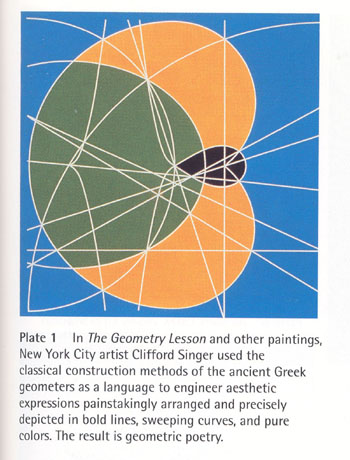 2.
2.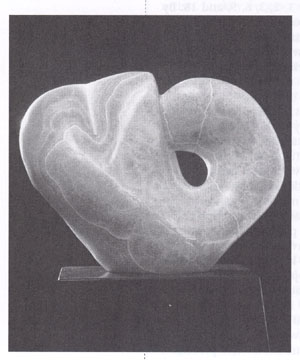
2. Helamen
Ferguson, Eine Kleine
Rock Musik III. To create Eine
Kleine Rock Musik III,
Ferguson quarried a sixty-pound piece of creamily streaked honey onyx in Utah, then carved it into a topological shape of a Klein bottle. A
Klein bottle has a curiously contorted surface that passes through itself and
emerges again from the other side.
3. Celso Costa
originally discovered this kind of surface by devising equations inspired by
the sweeping curves of skirts and hats worn by dancers in Rio de Janeiro's
famous Carnival. These equations represented an unbounded minimal surface
threaded by several tunnels. Other researchers discovered by use of computer
images based on the equations that the surface did not intersect itself. Hence
it was a member of an elite group, the other members being the plane, the catenoid and the helicoid.
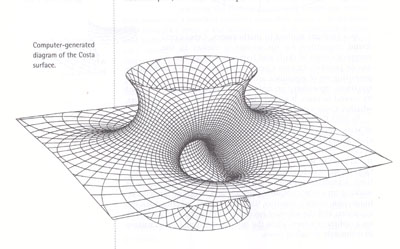
The figure (above) has the splendid elegance
of a gracefully spinning dancer flinging out her full skirt so it whirled
parallel to the ground. A gentle wave ruffled the skirt's hem. Two holes
pierced the skirt's lower surface and joined to form a tunnel that swept
upward. Another pair of holes, set at right angles to the first pair, led from
the top of the skirt downward into a second tunnel.
The Costa surface is one of an infinite
number of such unbounded minimal surfaces, each with a different number of
tunnels penetrating the form's interior and opening up into wide mouths, like
trumpet bells. (162-3)
[JB's comment: Although the Costa surface
image is an purely mathematical diagram, it invites
artists to make use of it. In that way it belongs in this section. In class I
will exhibit materials from a website of a mathematician, Thomas Banchoff. The address is:
http://www.geom.uiuc.edu/~banchoff.]
5. THE BEST OF PHYSICS: What Makes an
Equation Beautiful?
By KENNETH CHANG
CONSIDER a verbal description of the effect
of gravity: drop a ball, and it will fall.
That is a true enough fact, but fuzzy in the
way that frustrates scientists. How fast does the ball fall? Does it fall at
constant rate, or accelerate? Would a heavier ball fall faster? More words,
more sentences could provide details, swelling into an unwieldy yet still
incomplete paragraph.
The wonder of mathematics is that it captures precisely in a few symbols what
can only be described clumsily with many words. Those symbols, strung together
in meaningful order, make equations - which in turn constitute the world's most
concise and reliable body of knowledge. And so it is that physics offers a very
simple equation for calculating the speed of a falling ball.
Readers of Physics World magazine recently were asked an interesting
question: Which equations are the greatest?
Dr. Robert P. Crease, a professor of philosophy at the State University of New
York at Stony Brook and a historian at Brookhaven National Laboratory, posed
the question in his Critical Point column and received 120 responses,
nominating 50 different equations. Some were nominated for the sheer beauty of
their simplicity, some for the breadth of knowledge they capture, others for
historical importance. In general, Dr. Crease said, a great equation
"reshapes perception of the universe."
The mathematical equation providing the speed of a falling ball is just four
symbols long: v = gt.
With it, you can calculate the ball's speed 2.5
seconds after release. (That's g, the acceleration of gravity, which is 32 feet
per second squared, multiplied by 2.5 seconds, giving an answer of 80 feet per
second.)
This equation, a mainstay of high school physics, was not among those nominated
as the greatest of all time, which is not surprising, because its use is
limited.
The pull of gravity varies with distance from the Earth's surface, and the
equation also suggests that an object's speed could go on increasing toward
infinity, past the known limit of the speed of light.
The top vote-getters in the magazine poll were Maxwell's equations - a set of
four that describe the interplay between electric and magnetic fields - and
Euler's equation, a purely mathematical construct that finds wide use in
theoretical physics.
"It combines rational and irrational numbers to get zero," Dr. Crease
said. "It's bizarre."
Among the other nominees were the all-familiar E=mc2 from Einstein, which
equates energy and matter; the Pythagorean theorem;
and Isaac Newton's F=ma.
Prominent scientists have their own favorites. Dr. Brian Greene, a theorist at
Columbia University and author of "The Elegant Universe," cites
Einstein's general relativity equations, which describe how matter warps the
fabric of space, and the Schrödinger equation, the fundamental equation of
quantum mechanics.
"With a mere handful of symbols, those equations describe almost all
phenomena in the universe," he said. "It is so amazing how so much of
the universe is encapsulated in a few symbols."
Dr. Neil deGrasse Tyson, director of the Hayden
Planetarium, said he was disappointed that E=mc2 did not receive more votes.
"I think the general physics community, they're a little bored with the
equation," he said. "It's risen to the level of icon that people no
longer pay attention to."
But Dr. Tyson said that the equation was a fundamental underpinning not only of
the universe, but also of the first five chapters of his book
"Origins."
"It's simple, yet profound," he said. "I'd be less impressed if
it were a big complicated equation."
A half-dozen of Dr. Crease's respondents, including Richard Harrison of
Calgary, Alberta, chose one of the simplest possible equations.
Mr. Harrison wrote: " '1 + 1 = 2' is the fairy
tale of mathematics, the first equation I taught my son, the first expression
of the miraculous power of the mind to change the real world. I remember my son
holding up the index finger, the 'one finger,' of each hand as he learned the
expression, and the moment of wonder, perhaps his first of true philosophical
wonder, when he saw that the two fingers, separated by his whole body, could be
joined in a single concept in his mind."
Copyright 2004 The
New York Times Company
6. Jonathan Swift on the Laputans' obsession with mathematically regular forms, from
Gulliver's Travels, 1729.
Here we have a description of the imaginary Laputan culture, in which things like Marquardt's
beauty-mask might be highly prized -- one that is not put off by the conflict
between natural and geometrical forms that I complained of in class. Music is
associated with mathematics because of the mathematical ratios exemplified by
the harmonies within the overtone scale. (The shape of musical instruments,
however, is only loosely associated with those properties.)
[The Laputans'] Ideas are perpetually conversant in Lines and Figures. If they would, for Example, praise the Beauty of a Woman, or any other Animal, they describe it by Rhombs, Circles, Parallelograms, Ellipses, and other Geometrical Terms, or else by Words or Art drawn from Musick, needless here to repeat...
They also apply geometry to the carving of meat and other dishes that lent themselves to being shaped: "In the first Course, there was a Shoulder of Mutton, cut into an AEquilateral Triangle; a Piece of Beef into a Rhomboides; and a Pudding into a Cycloid. The second Course was two Ducks, trussed up into the Form of Fiddles; Sausages and Puddings resembling Flutes and Hautboys, and a Breast of Veal in the Shape of a Harp. (1) The Servants cut our Bread into Cones, Cylinders, Parallelograms, and several other Mathematical Figures."
[1. This symbolism is only
loosely or indirectly associated with the mathematics, of course.]
7. Hutcheson's application of the
criterion of uniformity and variety to geometrical and astronomical examples.
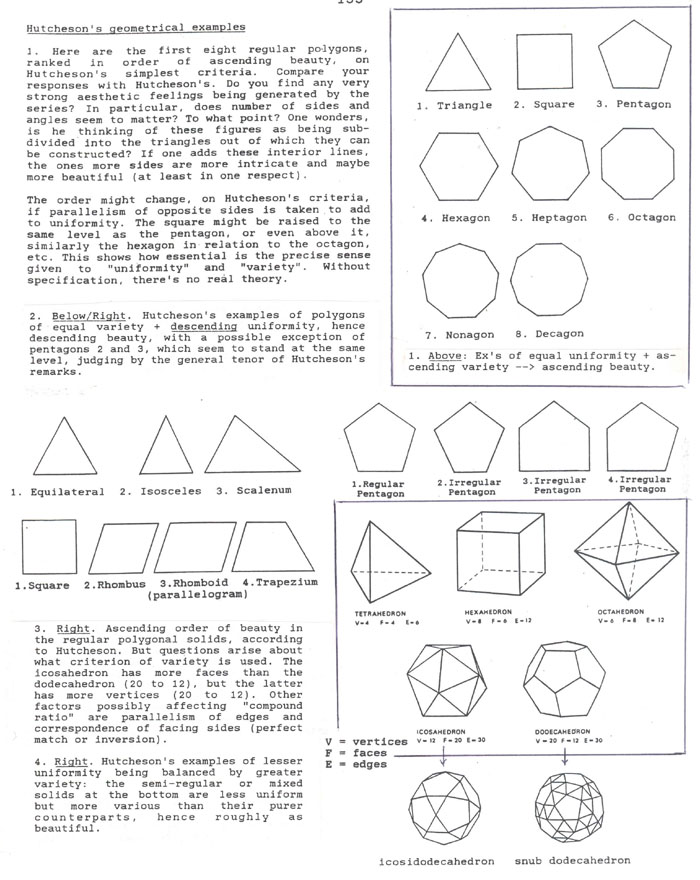
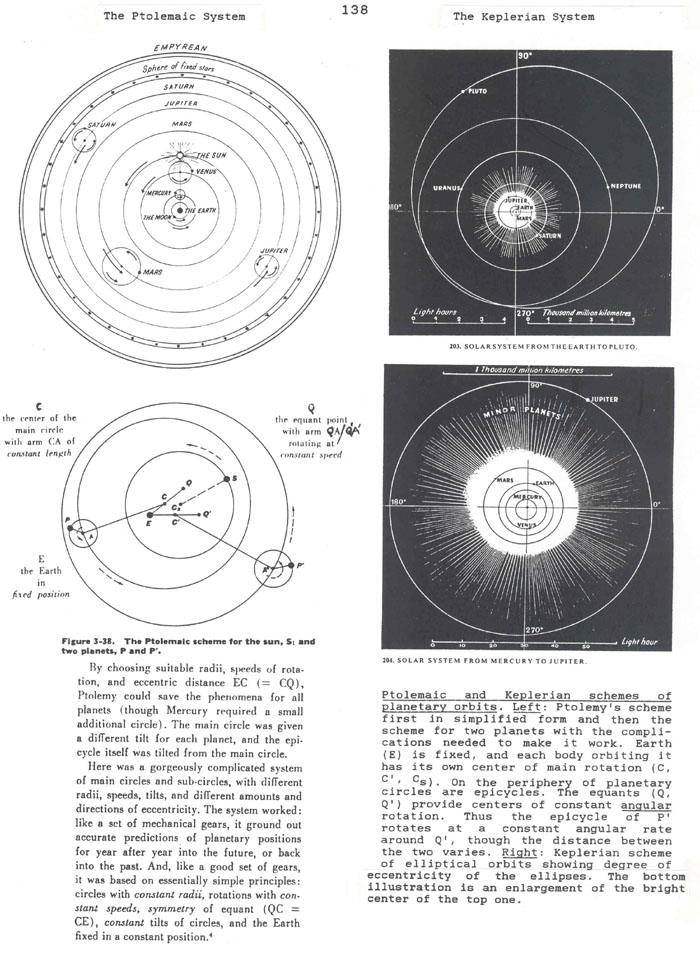
8. Modes of architecture (in reference to
Apollonian v. Dionysian beauty)
8.1 Classical Greek temple design
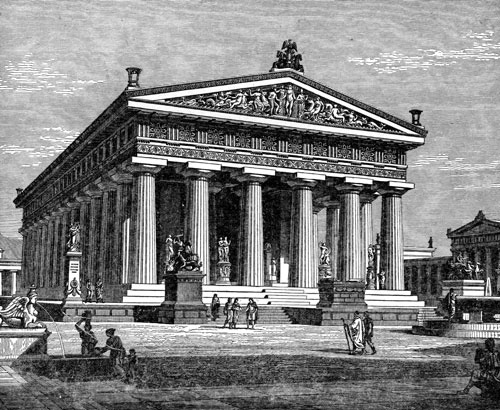
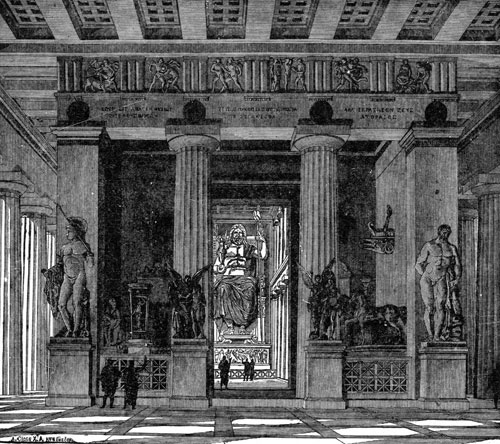

8.2. Two arguably Dionysian modes, Gothic
cathedrals and Hindu temples
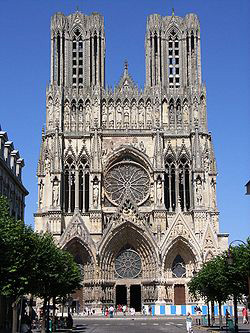
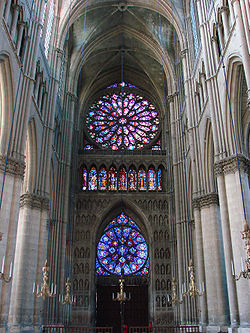
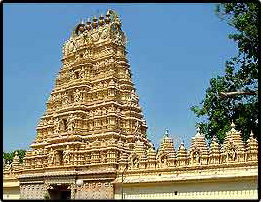
8.3. An intermediate case, cool modernism,
National Gallery East Wing

8.4. Frank Gehry's complexly flowing architecture. And where do these works fit on the
Apollonian-Dionysian scale? How are its beauties to be described?
Here are, in order, a conceptual sketch, a
north and a west elevations, and the finished building
seen from the north. The building is discussed briefly in Item 8 in the
Discussions folder. Descriptions given after the pictures are culled from Kurt
W. Forster, Frank O. Gehry: Guggenheim Bilbao Museoa, Stuttgart and London: Edition Axel Menges, 1998. The photograph here and those shown in class
are from the same volume, and are by Ralph Richter.
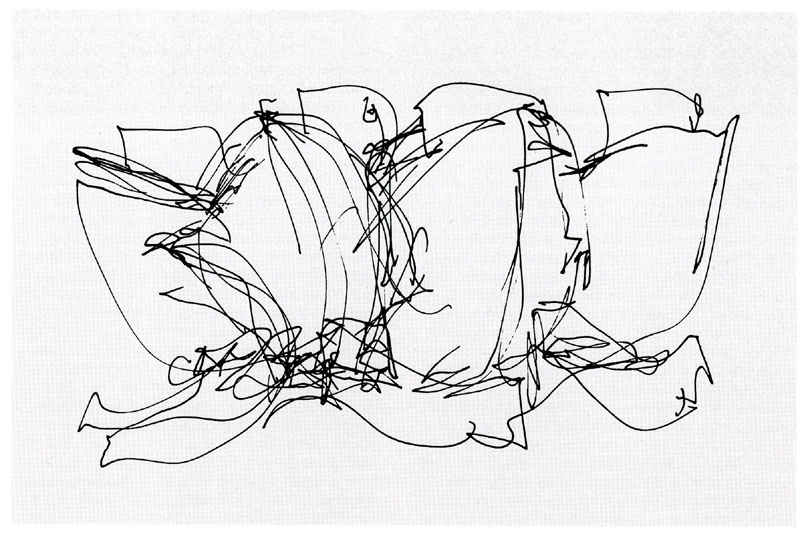


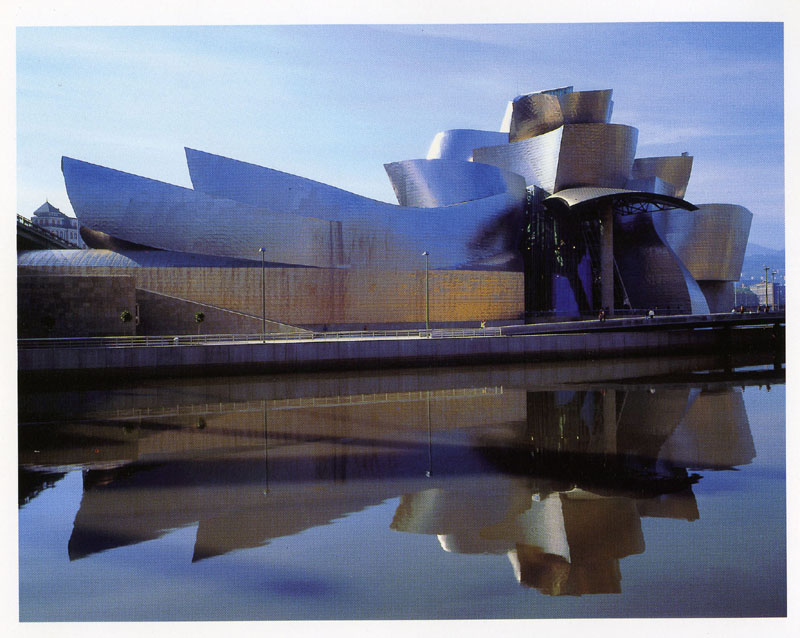
Forster's description of
the building (excerpts). "...the museum has been anchored in the cityscape
of Bilbao [Portugal] like a vast circus tent surrounded by a congerie[s] of caravans, for the variety of events
anticipated to take place there requires large and ever varying venues.
Subsidiary spaces are clustered together, squeezed through the bottleneck
between river and embankment, made to duck under bridges, and finally allowed
to soar over the building's core in a spectacular canopy. All this implies
motion induced by internal tension and external compression and gives rise to
the towering and seemingly revolving space of the central hall.." And later, "...the Bilbao Guggenheim must be
reckoned overweight, overdone, and overwhelming. Its excessive qualities are
precisely those that enable it to assume several different roles at once. It is
an immovable pile in the city and a sinuous creature draping its body along a
narrow ledge above the river. As a luminous cave on the inside, and a metallic
mountain from without, the museum appears to be both a perfect fit and a
perfect stranger in its site. Excess designates the state of the building,
exuberance its true nature." And, "From the very start, the sketches
for Bilbao seemed to have the capacity to soar. They expanded energy as if it were free, and this freedom not only generated forms
previously thought to be impossible, but also unfit for integration into a
complicated site." Forster also emphasizes how Gehry
thinks of the complexly curvilinear elements of his buildings as bodies which
he "sets...in motion as a choreographer does his or her dancers."
Following-up the class discussion of the
order in Gehry's design, here are two simplifications
of Gehry's design, intended to test whether people
prefer a comparatively simpler order in a building of this type. Of course I
concede that my simplification may produce aesthetic disharmony, since I have
altered things using only the forms I could copy and paste in Photoshop. There
is also the unknown impact on the interior space, but let us suppose that is
essentially like the effect on the exterior. Compare the modified designs with
the original shown above. Also ask yourself whether Forster's description
applies equally to these simplifications.
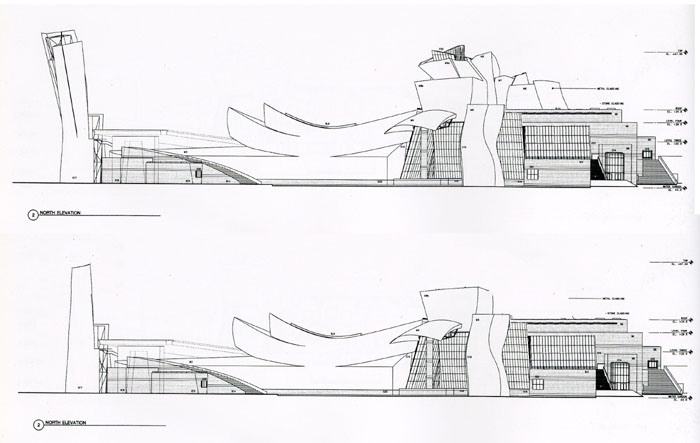
9. Illustrations for lecture on
Apollonian and Dionysian beauties.
a. Arguably Dionysian pottery and
sculpture: Pre-Columbian pots and a contemporary Venus-Gaia sculpture.

Mayan vessel
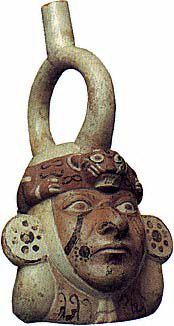
Peruvian vessel (Mocha culture)
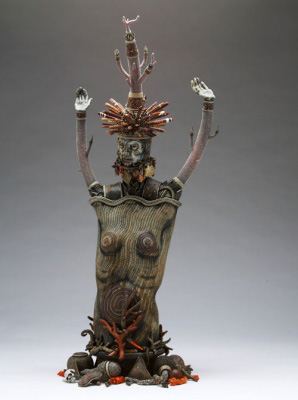
Marko Fields sculpture
b. Apollonian color preferences:
Clear, well-differentiated color as in Ghirlandaio's portrait of Giovanna Tornabuoni.
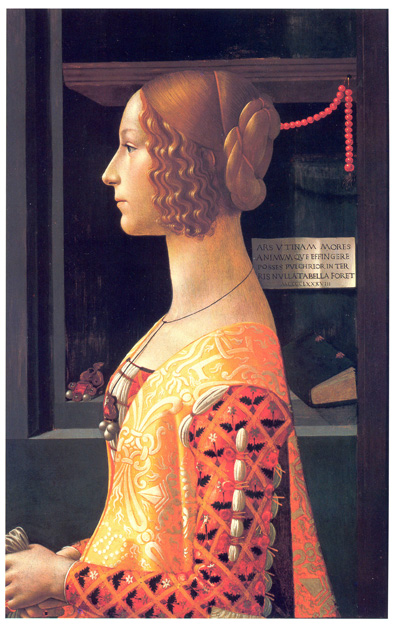
An example of Dionysian color
preference: Domienico Feti,
Flight into Egypt,
1621-23.

Radically Dionysian painting: Wassily Kandinsky, Improvisation 1911:
http://www.guggenheim.org/new-york/collections/collection-online/show-full/piece/?search=Improvisation%2028%20(second%20version)&page=&f=Title&object=37.239
See also Van Gogh's Starry
Night and Alberto Giacometti's Portrait of a
Man in Beauty Notes 24, "Apollonian and Dionysian."
Incontestably
Dionysian music.
Led Zepplin, "Whole Lotta
Love" http://www.youtube.com/watch?v=PU-PoUwECjI
Possibly a fusion
of Apollonian and Dionysian music. Beethoven.
http://www.youtube.com/watch?v=-kcOpyM9cBg&feature=fvw
10. A fictional aesthete of scent and
flavor (radically Dionysian)
Karl Joris Huysmans
(1848-1907) published his novel A Rebours (Against
Nature or Against the Grain )
in 1884. It created a sensation in Paris, instantly becoming a beacon for
the "decadents" in European culture of the end of the century. Its
protagonist, Des Esseintes, is an eccentric
aristocrat, the last of his line, whose neuraesthenia
(hyper-sensitivity) is almost heroic. The following excerpts are from Chs. 4 and 10. In some ways, and up to a point, he is an
energetic aesthetic investigator and insightful literary critic. But ultimately
his Dionysian excess does him in. His overexcited senses become really
deranged.
Des Esseintes stood gazing at the turtle where it lay huddied together in one corner of the dining-room, flashing fire in the dim half light.
He felt perfectly happy; his eyes were intoxicated with the splendours of these flowers flashing in jewelled flames against a golden background. Then, contrary to his use, he had an appetite and was dipping his slices of toast spread with superexcellent butter in a cup of tea, an impeccable blend of Si-a-Fayoun, Mo-you-tann and Khansky,-yellow teas, imported from China into Russia by special caravans.
This liquid perfume he drank from those cups of Oriental porcelain known as egg-shell china, so delicate and transparent are they; in the same way, just as he would have nothing to say to any other save this adorably dainty ware, he refused to use as dishes and plates anything else but articles of genuine antique silver-gilt, a trifle worn so that the underlying silver shows a little here and there under the film of gold, giving a tender, old-world look as of something fading away in a quiet death of exhaustion.
After swallowing his last mouthful, he went back to his study, whither he directed a servant to bring the turtle, which obstinately declined to make the smallest effort towards locomotion.
Outside the snow was falling. In the lamplight, ice arabesques glittered on the dark windows and the hoar-frost sparkled like crystals of sugar on the bottle-glass panes speckled with gold.
A deep silence wrapped the little house that lay asleep in the darkness.
Des Esseintes stood lost in dreams; the logs burning on the hearth filled the room with hot, stifling vapours, and presently he threw the window partly open.
Like an overhanging canopy of reversed ermine, the sky rose before him, a black curtain dappled with white.
An icy wind was blowing, that sent the snow spinning before it and soon reversed this first arrangement of black and white. The sky returned to the correct heraldic blazon, became a true ermine, white dappled with sable, where the black of night showed here and there through the gcneral whiteness of the snowy mantle of descending snowflakes.
He closed the window again. But this quick change, without any intermediate transition, from the torrid heat of the room to the cold of mid-winter had given him a shock; he crouched back beside the fire and thought he would swallow a dose of spirits to restore his bodily temperature.
He made his way to the dining-room, where in a recess in one of the walls, a cupboard was contrived, containing a row of little barrels, ranged side by side, resting on miniature stocks of sandalwood and each pierced with a silver spigot in the lower part.
This collection of liquor casks he called his mouth organ.
A small rod was so arranged as to connect all the spigots together and enable them all to be turned by one and the same movement, the result being that, once the apparatus was installed, it was only needful to touch a knob concealed in the panelling to open all the little conduits simultaneously and so fill with liquor the tiny cups hanging below each tap.
The organ was then open. The stops, labelled "flute," "horn," "vox humans," were pulled out, ready for use. Des Esseintes would, imbibe a drop here, another there, another elsewhere, thus playing symphonies on his internal economy, producing on his palate a series of sensations analogous to those wherewith music gratifies the ear.
Indeed, each several liquor correspondcd, so he held, in taste with the sound of a particular instrument. Dry curaçao, for instance, was like the clarinet with its shrill, velvety note; kiimmel like the oboe, whose timbre is sonorous and nasal; creme de menthe and anisette like the flute, at one and the same time sweet and poignant, whining and soft. Then, to complete the orchestra, comes kirsch, blowing a wild trumpet blast; gin and whisky, deafening the palate with their harsh outbursts of cornets and trombones; liqueur brandy, blaring with the overwhelming crash of the tubas, while the thunder peals of the cymbals and the big drum, beaten might and main, are reproduced in the mouth by the rakis of Chios and the mastics.
He was convinced too that the same analogy might be pushed yet further, that quartettes of stringed instruments might be contrived to play upon the palatal arch, with the violin represented by old brandy, delicate and heady, biting and clean-toned; with the alto, simulated by rum, more robust, more rumbling, more heavy in tone; with vespetro, long-drawn, pathetic, as sad and tender as a violoncello; with the double-bass, full-bodied, solid and black as a fine, old bitter beer. One might even, if anxious to make a quintette, add yet, another instrument; the harp, mimicked with a sufficiently close approximation by the keen savour, the silvery note, clear and self-sufficing, of dry cumin.
Nay, the similarity went to still greater length, analogies not only of qualities of instruments, but of keys were to be found in the music of liquors; thus, to quote only one example, Benedictine figures, so to speak, the minor key corresponding to the major key of the alcohols which the scores of wine-merchants' price-lists indicate under the name of green Chartreuse.
These assumptions once granted, he had reached a stage, thanks to a long course of erudite experiments, when he could execute on his tongue a succession of voiceless melodies; noiseless funeral marches, solemn and stately; could hear in his mouth solos of creme de menthe, duets of vespetro and rum.
He even succeeded in transferring to his palate selections of real music, following the composer's motif step by step, rendering his thought, his effects, his shades of expression, by combinations and contrasts of allied liquors, by approximations and cunning mixtures of beverages.
Sometimes again, he would compose pieces of his own, would perform pastoral symphonies with the gentle blackcurrent ratafia that set his throat resounding with the mellow notes of warbling nightingales; with the dainty cacao-chouva, that sung sugarsweet madrigals, sentimental ditties like the "Romances d'Estelle"; or the "Ah! vous di-rai-je maman," of former days.But to-night, Des Esseintes had no wish to "taste" the delights of music; he confined himself to sounding one single note on the keyboard of his instrument, filling a tiny cup with genuine Irish whisky and taking it away with him to enjoy at his leisure.
He sank down in his armchair and slowly savoured this fermented spirit of oats and barley-a strongly marked, almost poisonous flavour of creosote diffused itself through his mouth.
Little by little, as he drank, his thoughts followed the impression thus re-awakened on his palate, and stimulated by the suggestive savour of the liquor, were roused by a fatal similarity of taste and smell to recollections half obliterated years ago.
The acrid, carbolic flavour forcibly recalled the very same sensation that had filled his mouth and burned his tongue while the dentists were at work on his gums.In the course of that singular malady which plays such havoc with races of exhausted vitality, sudden intervals of calm succeed the crises. Without being able to explain the reason, Des Esseintes awoke quite strong and well one fine morning; no more hacking cough, no more wedges driven with a hammer into the back of the neck, but an ineffable sensation of well-being and a delightful clearness of brain, while his thoughts became cheerful; and instead of being opaque and dull, grew bright and iridescent, like brilliantly coloured soap bubbles.
This lasted some days; then in a moment, one afternoon, hallucinations of the sense of smell appeared.
His room was strong of frangipane. He looked to see if perhaps there was a bottle of the perfume lying about anywhere uncorked; but there was no such thing in the place. He visited his working-room and then the dining-room; the smell was there too.
He rang for his servant. "Don't you smell something?" he asked, but the man, after sniffing the air, declared he noticed nothing. Doubt was impossible; the nervous derangement was come again, taking the form of a fresh delusion of the senses.
Wearied by the persistency of this imaginary aroma. he resolved to plunge himself in a bath of real perfumes, hoping that his nasal homeopathy might cure him or, at any rate, moderate the force of the overpowering frangipane.
He betook himself to his study. There, beside an ancient font that served him as a wash-hand basin, under a long looking-glass in a frame of wrought iron that held imprisoned like a well-head silvered by the moonlight the pale surface of the mirror, bottles of all sizes and shapes were ranged in rows on ivory shelves. He placed them on a table and divided them into two series; first, the simple perfumes, extracts and distilled waters; secondly, composite scents, such as are described under the generic name of bouquets.
He buried himself in an armchair and began to think. Years ago he had trained himself as an expert in the science of perfumes; he held that the sense of smell was qualified to experience pleasures equal to those pertaining to the ear and the eye, each of the five senses being capable, by dint of a natural aptitude supplemented by an "erudite education, of. receiving novel impressions, magnifying these tenfold, coordinating them, combining them into the whole that constitutes a work of art. It was not, in fact, he argued, more abnormal than an art should exist of disengaging odoriferous fluids than that other arts should whose function is to set up sonorous waves to strike the car or variously coloured rays to impinge on the retina of the eyes; only, just as no one, without a special faculty of intuition developed by study, can distinguish a picture by a great master from a worthless daub, a motif of Beethoven from a tune by Clapisson, so no one, without a preliminary initiation, can avoid confounding at the first sniff a bouquet created by a great artist with a pot-pourri compounded by a manufacturer for sale in grocers' shops and fancy bazaars.
In this art of perfumes, one peculiarity had more than all others fascinated him, viz. the precision with which it can artificially imitate the real article.
Hardly ever, indeed, are scents actually produced from the flowers whose name they bear; the artist who should be bold enough to borrow his element from Nature alone would obtain only a half-and-half-result, unconvincing, lacking in style and elegance, the fact being that the essence obtained by distillation from the flowers themselves could at the best present but a far-off, vulgarized analogy with the real aroma of the living and growing flower, shedding its fragrant effluvia in the open air.
So, with the one exception of the jasmine, which admits of no imitation, no counterfeit, no copy, which refuses even any approximation, all flowers are perfectly represented by combinations of alcoholates and essences, extracting from the model its inmost individuality while adding that something, that heightened tone, that heady savour, that rare touch which makes a work of art.
In one word, in perfumery the artist completes and consummates the original natural odour, which he cuts, so to speak, and mounts as a jeweller improves and brings out the water of a precious stone.
Little by little, the arcana of this art, the most neglected of all, had been revealed to Des Esseintes, who could now decipher its language,– a diction as varied, as subtle as that of literature itself, a style of unprecedented conciseness under its apparent vagueness and uncertainty.
To reach this end, he had, first of all, been obliged to master the grammar, to understand the syntax of odours, to grasp the rules that govern them; then, once familiarized with this dialect, to study and compare the works of the divers masters of the craft, the Atkinsons and Lubins, the Chardins and Violets, the Legrands and Piesses, to analyze the construction of their sentences, to weigh the proportion of their words and the disposition of their periods.
Next, in this idiom of essences, it was for experience to come to the assistance of theories
too often incomplete and commonplace.
The classic art of perfumery was, in truth, little diversified, almost colourless, uniformly run in a mould first shaped by old-world chemists; it was in its dotage, hide-bound in its ancient alembics, when the Romantic epoch dawned and took its part in modifying, in rejuvenating it, in making it more malleable and more supple.
Its history followed step by step that of the French language. The Louis XIII. style, perfumed and full-flavoured, compounded of elements costly at that date, of iris powder, musk, civet, myrtle water, already known by the name of Angels' Water, barely sufficed to express the rude graces, the rather crude tints of the time which certain sonnets of Saint-Amand's have preserved for us. Later on, with the introduction of myrrh, frankincense, the mystic scents, powerful and austere, the pomp and stateliness of the Grand Siècle, the redundancy and artificiality of the orator's art, the full, sustained, wordy style of Bossuet and the great preachers became almost possible; later on again, the well-worn, sophisticated graces of French society under Louis XV found a readier interpretation of their charm in the frangipane and marichale, which offered in their way the very synthesis of the period. Then finally, after the indifference and incuriousness of the First Empire, which used Eau de Cologne and preparations of rosemary to excess, perfumery ran for inspiration, in the train of Victor Hugo and Gautier, to the lands of the sun; it created Oriental essences, selams overpowering with their spicy odours; invented new savours; tried and approved old tones and shades .now rediscovered, which it made more complex, more subtle, more choice; definitely repudiating once for all the voluntary decrepitude to which the art had been reduced by the Malesherbes, the Andrieux, the Baour-Lormians, the vulgar distillers of its poetry.
Nor had the language of perfumes remained stationary since the epoch of 1830. Again it had progressed and following the march of the century had advanced side by side with the other arts. It, too, had complied with the whims of amateurs and artists, flying for motives to China and Japan, inventing scented albums, imitating the flowery nosegays of Takeoka; by a mingling of lavender and clove obtaining the perfume Rondeletia; by a union of patchouli and camphor, the singular aroma of India-ink; by compounding citron, clove and neroli (essence of orange blossoms), the odour, the Hovenia of Japan.
Des Esseintes studied, analyzed the soul of these fluids, expounded these texts; he took a delight, for his own personal satisfaction, in playing the part of psychologist, in unmounting and remounting the machinery of a work, in unscrewing the separate pieces forming the structure of a complex odour, and by long practice of this sort, his sense of smell had arrived at the certainty of an almost infallible touch. Just as a wine-merchant knows the vintage by imbibing single drop; as a hop-dealer, the instant he sniffs at a bag, can there and then name its precise quality and price; as a Chinese trader can declare at once the place of origin of the teas he examines, say on what farms of the Bohea mountains, in what Buddhist Monasteries, each specimen was grown, and the date at which its leaves were gathered, can state precisely the degree of heat used and the effect produced by its contact with plum blossom, with the Aglaia, with the Olea fragrans, with all or any of the perfumes employed to modify its flavour, to give it an added piquancy, to brighten up its rather dry savour with a whiff of fresh and alien flowers; even so could Des Esseintes, by the merest sniff at a scent, detail instantly the doses of its composition, explain the psychology of its blending; all but quote the name of the particular artist who wrote it and impressed on it, the personal mark of his style.
Needless to say, he possessed a collection of all the products used by perfume-makers; he had even some of the true Balm of Mecca, a very great rarity, to be procured only in certain regions of Arabia Petraa and guarded as a monopoly of the Grand Turk.
Seated now in his study at his working table, he was pondering the creation of a new bouquet, aid had reached that moment of hesitation so familiar to authors who, after months of idleness, are preparing to start upon a fresh piece of work.
Like Balzac, who was haunted by an .imperious craving to blacken reams of paper by way of getting his hand in, Des Esseintes felt the necessity of recovering his old cunning by dint of executing some task of minor importance. He determined to make heliotrope, and measured out the proper quantities from phials of almond and vanilla; then he changed his mind and resolved to try sweet-pea.
The phrases, the processes had escaped his memory. So he made experiments. No doubt in the fragrance of that flower, orange blossom was the dominant factor; he tried a number of combinations and ended by getting the right tone by blending the orange with the tuberose and rose, binding the three together with a drop of vanilla.
All his uncertainties vanished; a fever of eagerness stirred him, he was ready to set to work in earnest. He compounded a fresh brew of tea, adding a mixture of cassia and iris; then, sure of himself, he resolved to march boldly forward, to strike a thundering note, the overmastering crash of which should bury the whisper of that insinuating frangipane which still stealthily impregnated the room.
He handled amber; Tonquin musk, with its overpowering scent; patchouli, the most pronounced of all vegetable perfumes, whose blossom, in the natural state, gives off an odour compounded of wet wood and rusty iron. Do what he would, the associations of the eighteenth century haunted him, gowns with paniers and furbelows hovered before his eyes; memories of Boucher's "Venus," all flesh, without bones, stuffed with pink cotton-wool, beseiged him; recollections of the novel Thémidore and the exquisite Rosette with skirts high lifted in a fire-red despair, pursued him. In a rage, he sprang up and, to shake himself free from the obsession, sniffed in with all his might that unadulterated essence of spikenard that is so dear to Easterns and so disagreeable to Europeans, by reason of its over-strong savour of valerian. He staggered under the violence of the shock; as if crushed under the blow of a mallet, the delicate fibrils of the dainty scent disappeared. He took advantage of the moment's respite to escape from the dead centuries, the old-tune emanations, to enter, as he had been used to do in other days, on creations less limited in scope and more modern in fashion.
Of old, he had loved to soothe his spirit with harmonies in perfumery; he would use effects analogous to those of the poets, would adopt, in a measure, the admirable metrical scheme – characterizing certain pieces of Baudelaire's, for instance "1'Irréparable" and "le Balcon," where the last of the five lines composing the strophe is the echo of the first, returning like a refrain to drown the soul in infinite depths of melancholy and languor.
He wandered, lost in the dreams these aromatic stanzas called up in his brain, till suddenly recalled to his starting point, to the original motif of his meditations, by the recurrence of the initial theme, re-appearing at studied intervals in the fragrant orchestration of the poem.
For the actual moment, he was fain to roam in freedom amid a landscape full of surprises and changes, and he began by a simple phrase,– ample, sonorous, at once opening a view over an immense stretch of country.
With the help of his vaporizers, he injected into the room an essence composed of ambrosia, Mitcham lavender, sweet pea, compound bouquet; – an essence which, if distilled by a true artist, well deserves the name bestowed on it of "extract of meadow flowers"; then, into this meadow, he introduced a carefully modulated infusion of tuberose, orange and almond blossom, and instantly artificial lilacs came into being, while lindens swayed in the breeze, shedding on the ground about them their pale emanations, mimicked by the London extract of tilia.
This scene, once arranged in a few imposing lines, melting to the horizon under his closed eyes, he insinuated a light rain of human, not to say half feline, essences, smacking of the petticoat, announcing woman powdered and painted,– the stephanotis, the ayapana, the opoponax, the chypre, the champaka, the sarcanthus, over which he superimposed a dash of seringa, to suggest, amid the factitious life of make-up and make-belief which they evoked, a natural flower of hearty, uncontrolled laughter, of the joys of existence in the eye of the sun.
Then he let these fragrant waves escape by a ventilator, keeping only the country scent,
which he renewed and reinforced, strengthening the dose so as to force it to recur like the burden of a song at the end of each strophe.
Little by little, the feminine aroma disappeared, the country was left without inhabitants. Then, on the enchanted horizon, rose a row of factories whose tall chimneys flamed at their tops like so many bowls of punch.
A breath as of manufactories, of chemical works now floated on the breeze which he raised by waving fans, though Nature still continued to sweeten with her fragrant emanations this foulness of the atmosphere.
Des Esseintes proceeded to turn about and warm between his hands a ball of styrax, and a very curious odour filled the room, a smell at once repugnant and exquisite, blending the delicious scent of the jonquil with the filthy stench of guttapcrcha and coal tar. He disinfected his hands, shut away his resin in a box hermetically scaled, and the stinking factories vanished in their turn. Then, he tossed amid the revivified vapours of lindens and meadow-grass some drops of "new mown hay," and on the magic spot, instantly bared of its lilacs, rose mounds of hay, bringing with them a new season, scattering their delicate odours reminiscent of high summer.
Last of all, when he had sufficiently savoured the sight, he hurriedly scattered about exotic perfumes, exhausted his vaporizers, concentrated his strongest essences, gave the rein to all his balms, and lo! the stifling closeness of the room was filled with an atmosphere, maddening and sublime, breathing powerful influences, impregnating with raging alcoholates an artificial breeze,– an atmosphere unnatural, yet delightful, paradoxical in its union of the allspice of the Tropics, the pungent savours of the sandalwood of China and the hediosmia of Japan with native odours of jasmine, hawthorn and vervain, forcing, to grow together, in despite of seasons and climates, trees of diverse essences, flowers of colours and fragrances the most opposite, creating by the blending and shock of all these tones one common perfume, unknown, unforeseen, extraordinary, wherein re-appeared at intervals as a persistent refrain, the decorative phrase of the opening, the odour of the broad meadows breathed over by the lilacs and the lindens.
Suddenly a sharp agony assailed him; it felt as though a centre-bit were boring into his temples. He opened his eyes, to find himself once more in the middle of his study, seated before his working table; he got up and walked painfully, half-stunned, to the window, which he threw part open. A current of fresh air sweetened the stifling atmosphere that enveloped him; he marched up and down the room to recover the proper use of his limbs, going to and fro, his eyes fixed on the ceiling on which crabs and seaweed powdered with sea salt stood out in relief from a grained background, yellow as the sand of a beach. A similar design decorated the plinths bordering the panels, which in their turn were covered with Japanese crape, a watery green in colour and slightly waved to imitate the ripple of a wind-blown river, while down the gentle current floated a rose leaf round which frolicked a swarm of little fishes dashed in with two strokes of the pen.
But his eyes were still heavy; he left off pacing the short length of floor between the font and the bath and leant his elbows on the window sill. Presently his dizziness ceased, and after carefully recorking the bottles of scents and essences, he seized the opportunity to tidy his apparatus for making up the face,– his paints and powders and the like. He had not touched these things since his arrival at Fontenay, and he was almost astonished now at the sight of this collection once visited by so many women. One on top of the other, phials and porcelain pots littered the table confusion. Here was a china box, of the green sort, containing schnouda, that marvellous white cream which, once spread on the checks, changes under the influence of the air to a tender pink, then to a scarlet so natural that it gives an absolutely convincing illusion of a complexion mantling with red blood; there, jars incrusted with mother-o'-pearl held Japanese gold and Athens green, coloured like the wing of the cantharides beetle, golds and greens that blend into a deep purple directly they are moistened; beside pots full of filbert paste, of rerkis of the harem, of emulsions of Cashmere lilies, of lotions of strawberry and elderflower for the skin, beside little phials of solutions of India-ink and rose-water for the eyes, lay a host of different instruments, of mother-o'-pearl, of ivory and of silver, mixed up with dainty brushes for the teeth and gums, – pincers, scissors, strigils, stumps, crimpers, powder-puffs, back-scratchcrs, patches and files.
He handled all this elaborate apparatus, bought in former days to please a mistress who found an ineffable pleasure in certain aromatics and certain balms, an ill-balanced, nerve-ridden woman, who loved to have her nipples macerated in scents, but who only really experienced a genuine and overmastering ecstasy when her head was tickled with a comb and she could, in the act of being caressed by a lover, breathe the smell of chimney soot, of wet plaster from a house building in rainy weather, or of dust churned up by the heavy thunder drops of a summer storm.
He pondered these recollections, recalling particularly an afternoon spent, partly for want of anything better to do, partly out of curiosity, in this woman's company at her sister's house at Pantin, the memory of which stirred in his breast a whole forgotten world of long-ago thoughts and oldtime scents. While the two women were chattering and showing each other their frocks, he had gone to the window and, through the dusty panes, had looked out on the long, muddy street and heard its pavements echo under the incessant beat of heavy boots trampling through the puddles.
The scene, now far away in the past, suddenly stood out before him with extraordinary vividness: Pantin lay there in front of his eyes, bustling and alive, imaged in the green, dead water of the mirror into which his eyes involuntarily gazed. A hallucination carried him far away from Fontenay; the looking-glass reproduced for him the same reflections the street had once presented to his bodily eye, and buried in a dream, he said over the ingenious, melancholy yet consoling, anthem he had noted down on that former occasion on getting back to Paris: –
"Yea, the time of the great rains is come; behold, the gutter-pipes vomit their drippings on to the pavements, with a song of many waters, and the horse-dung lies fermenting in the puddles that fill the holes in the macadam with a coffee-colourcd fluid; everywhere, for the humble wayfarer, are foot-baths full to overflowing.
"Under the lowering sky, in the dull air, the walls of the houses drip black sweat and the cellar-openings stink; loathing of life is strong within the soul and the spleen is a torment to the flesh; the seeds of filthiness that every man has in his heart begin to bud; cravings for foul pleasures trouble the austerest and in the brain of respectable folks criminal desires spring up.
"And yet, there I am, warming myself before a blazing fire, while a basket of blowing flowers on a table fills the room with a sweet savour of benzoin, geranium and bentgrass. In mid- November, it is still spring-time at Pantin, in the Rue de Paris, and I find myself laughing in my sleeve to think of the timorous family parties that, in order to avoid the approach of winter, fly to Antibes or Cannes as fast as steam will take them.
"Inclement Nature goes for nothing in this strange phenomenon; it is to industry, to commerce, and that alone, be it said, that Pantin owes this artificial spring.
"The truth is, these flowers are of lustring, mounted on brass-wire, and the spring-like fragrance floating in through the cracks of the window-frame, is exhaled by the neighbouring factories where Pinaud and Saint-James make their perfumes.
"For the artisan exhausted by the hard labour of the workshops, for the small clerk, alas! only too often a father, the illusion of a breath or two of good air is a possibility– thanks to these manufacturers.
"Indeed, out of this scarce believable illusion of the country may be developed a quite rational medical treatment. Fast livers affected by chest complaints who are now carted off to the South mostly die, broken down by the rupture of all their habits of life, by the homesick craving to return to the Parisian pleasures that have brought them to this pass by their excess. Here, in an artificial climate, heated and regulated by stoves, libertine recollections will return, gently and harmlessly, along with the languishing feminine emanations given off by scent factories. In lieu of the deadly dreariness of provincial existence, the physician can by this device supply his patient platonically with the longed-for atmosphere of Parisian boudoirs, of Parisian haunts of pleasure.
"In the majority of cases, all that will be required to complete the cure is for the sick man to possess a little touch of imagination.
"Now, seeing that, in these times of ours, there is no single thing really genuine to be found; seeing that the wine we drink and the liberty we acclaim are equally adulterate and derisory; considering how remarkable a dose of credulity it takes to suppose the governing classes to deserve respect and the lower to be worthy either of relief or commiseration, it appears to me," concluded Des Esseintes, "neither more absurd nor more insane to demand of my neighbour a sum total of illusion barely equal to that he expends every day in his life for quite idiotic objects, that he may successfully persuade himself that the town of Pantin is an artificial Nice, a factitious Menton.""All which," he exclaimed, rudely interrupted in his reflexions by a sudden failure of all his bodily powers, "does not alter the fact that I must beware of these delicious and abominable experiments that are killing me." He heaved a sigh: "Well, well, more pleasures to moderate, more precautions to take," – and he retired for refuge to his study, thinking in this way to escape more easily from the haunting influence of the perfumes.
He threw the window wide open, delighted to enjoy an air bath; but next moment, the wind seemed to bring with it a vague breath of essence of bergamot, mingled with a smell of jasmine, cassia and rose-water. He shuddered, asking himself if he was not surely under the tyranny of one of those possessions by the devil that the Priests used to exorcise in the Middle Ages. Soon the odour changed and altered, however. An uncertain savour of tincture of tolu, balm of Peru, saffron, blended together by a few drops of amber and musk, now floated in from the sleeping village at the bottom of the hill; then, suddenly, in an instant, the metamorphosis was wrought, the scent of frangipine, of which his nostrils had caught the elements and were so familiar with the analysis, filled all the air from the valley of Fontenay away to the Fort, assailing his exhausted sense of smell, shaking afresh his shattered nerves, prostrating him to such a degree that he fell swooning and half dying across the window sill.
(Is this an aesthetic overdose, or what?)
11. Properties of scent (references are given at the end of this section)
11.1 Unquestionably odors are enormously
various. Humans with their 12,000,000 receptor neurons can discriminate
at least 10,000 of them, far more than the most refined machine can
distinguish. One percent of the human genome supports our olfaction. Of course
humans fall far short of the really big sniffers. Their quantity of receptors
comes nowhere near the bloodhound's 220 million! (Figures
from Rawson 260 and Glaser 96.) Olfactory stimuli are complex, setting
off different neurons that the brain reads as this or that odor. But the
mechanisms and the code are not yet known.
Molecules of odorants (things that smell)
adhere to the mucus surface of a membrane several square centimeters in size in
the two sides of our nasal passages. The receptors connect with the olfactory
bulb that relays messages to the brain. Only from 5 to 10% of the air we
breathe comes in contact with the membrane if our breathing is at its normal
rate, and only a fraction of the molecules carried by the air will get stuck on
the membrane. The central processing of the stimulations is not yet well
located or understood, but it is known that olfactory bulb sends signals
directly to the limbic system, the area that controls emotions and moods.
(King, in Van Toller et al 155)
There are many complications in odor
perception. For instance short-term adaptation (de-sensitization) occurs quite rapidly
– within a minute of initial exposure in the receptors. Long-term adaptation,
presumably in central processing, lasts hours or even weeks. On the other hand
long exposure may heighten sensitivity even after removal of the odorant.
Cross-adaptation occurs when one odorant decreases sensitivity to another.
False positives are easily produced: subjects told a disagreeable odor is being
released suffer an odor-hallucination although no (additional) scent is
diffused. Odors are sometimes confused with nasal irritations caused by some
substances. Aging and various other bodily conditions also affect sensitivity
negatively or positively. Genetic differences are thought to underlie some
variations in sensitivity. The extreme state of overall desensitivity
is called anosmia. No generally accepted threshold determining test exists at
present, different researchers using different procedures.
Odor differentiation tests exist in which
subjects assess odors for magnitude (intensity) and for sameness or difference
of character. In the fragrance industry expert "noses" identify
specific "notes" in a compound odor, the best noses distinguishing
thousands of "odorant qualities" (by which I think is meant
compounds). (Rawson, 267)
Odors famously affect salivation, sexual
arousal and emotional states. Odors are also potent aids to memory, especially
when the memory is emotionally charged. In the other direction odors described
as dangerous were judged more intense than the same when not so described. The
intimate connection of odor-perception and emotion makes for greater variations
of judgment of intensity, character and hedonic quality
(pleasantness/unpleasantness) of odors than one finds with colors or sounds.
There is also a more intimate connection between odor-perceptions and bodily
states, as in the case of odors making one nauseous.
Although ability to discriminate odors varies
only slightly between humans, the capacity to identify a variety of odors is
much improved by long training (years in duration). Without
such training even everyday odors are frequently misidentified, chocolate taken
to be coffee, cherry to be strawberry, even soy sauce for strawberry.
The "tip of the nose" phenomenon of not being able to identify a very
familiar odor is also common. Subjects generally score only about 50% on first
trials. On the other hand, correction after a failure produced 90% correct
identifications the second time around. To some extent the difficulty seems
connected with the weakness of the odor-to-language brain system: as if
perception of odors interfered with linguistic activation. But there are other
interferences: a red candy with apricot flavoring is apt to be judged
cherry-flavored. (Schab and Cain,
231).
Training in labeling scents produces somewhat
heightened discrimination as well as far better identification performances, a
circumstance that does not occur with, say, colors. Women are better
identifiers than are men. The blind outperform the sighted even when their
measured olfactory sensitivity is inferior. Elders seventy years old suffer
marked decline in both sensitivity and the power to identify or remember odors.
(Schab and Cain)
The descriptive teminology
for scent is heavily source-referential, that is, a given scent is described in
terms of the substances that produce it (one or other of such objects, that is). There is nothing comparable to the
source-free color-hue terms, blue, green, yellow. Thus smells are described as
the (odor of) cinnamon, violet, jasmine, etc. However, descriptions include a
variety of more or less source-independent predicates: warm, light, bright,
sweet, classic, romantic, feminine, harmonious, sensitive, sporty.
Some of these terms seem to refer partly to degrees of intensity, as when a
quality is said to be forceful (sharp) or mild, or zingy as
opposed to bland (or perhaps well-blended). Perhaps these are like degrees of
saturation or lightness of colors. Scents are also experienced as having more
or less "body," being large or thin, analogously to the
spatial quality of sounds. The source-independent terms which are most
analogous to color hues are sweet and bitter. Many of the terms
seem based on analogies with qualities in other modalities, color, sound,
taste, touch, and bodily sensation, with emotions or moods often serving as a
link.
Scent-perception has an important temporal
dimension, so that the source-referring descriptions may apply in a timed way
to "notes:" a "top note" comes across early, a "middle
note" after a moment and a "dry-out" note last, like an
aftertaste.
11.2. Odor descriptions of fragrant oils. From Rüdiger Hall, Dieter Klemme, Dr. Jürgen Nienhaus, The
H & R Guide to Fragrance Ingredients, 1985, (London, Johnson
Publications Ltd.)
Here is the first section of the alphabetically
arranged list of odor qualities (I omit the synthetic oils).
Ambergris: various nuances of woody, dry
balsamic, somewhat tobacco-like notes.
Angelic root oil: earthy, somewhat musk-like, peppery, aromatic odor with a
green, spicy top note.
Anise oil: very powerful, sweet, herbaceous and lively.
Artemisia oil: very bright, lively, somewhat herbaceous, spicy odor.
Asafoetida resinoid: very
intense onion, garlic-like odor.
Basil oil: very bright, lively, somewhat herbaceous, spicy odor.
Bay oil: very powerful, spicy, sweet odor with a distinct clove note.
Beeswax: mild, oily, sweet, honey-like odor with herbaceous notes.
Benzoin Siam resinoid: sweet balsamic, chocolate-like
odor of great tenacity.
Benzoin Sumatra resinoid: warm, sweet, powdery,
balsamic odor.
Bergamot oil: fresh, clear, lively odor, somewhat fruity and sweet which
displays great originality.
Birch tar oil: woody, tarry, smoky odor with pleasantly sweet, oily,
leather-like notes.
Boronia absolute: fruity, spicy-herbaceous odor with
sweet, rose-like and floral undertones.
Broom absolute: sweet, floral, hay-like fragrance with bitter undertones and
great originality.
Bruyère absolute: mild, balsamic, spicy-herbaceous
odor with dry woody notes.
Buchu leaf oil: very strong, minty-camphoraceous odor very reminiscent of black currants.
Cabreuva Oil: warm, woody, fatty odor.
Cade oil (Jupiter tar oil): lend strength and originality iin
small quantities to leather bases...
Cajuput oil: very powerful, herbaceous, eucalyptus-like odor.
Calamus oil: heavy, earthy, slightly sweet and
aromatic root-like odor with bitter undertones.
Calendula absolute: typical, very intense, bitter, herbaceous odor.
Cananga oil: warm sweet, floral and narcotic odor.
11.3. Odor classification
Classification is a major problem with odors.
There is no secure correlation of chemical sources with perceived odors:
"it has not even been possible to pin down the physiochemical attribute
that serves as a basis for differentiating between compounds that do and do not
activate this sense, let alone finer discrimination between such categories as goaty and minty odors." (Engen
45) In 1756 Linnaeus proposed the following types:
aromatic
fragrant
ambrosial (musky)
alliaceous (garlicky)
hircine (goaty)
repulsive or foul
nauseating
Amoore in 1970 divided odors as follows:
ethereal
floral
pepperminty
camphoraceous
musky
pungent
putrid
Another list was offered by Boelens in 1974:
ethereal
alliaceous
green
rancid (fatty)
burnt (pyrotic)
aromatic (spicy)
floral (fragrant)
woody
musky
nauseous
(Incidentally a good source for wine-tasting
terms is: http://www.stratsplace.com/hawkins/winetaste.html.)
11.4. A code for smell
In Evan Brown and Kenneth Deffenbacher's
Perception and the Senses, pp. 124ff. we are given recent thinking about
the peculiarities of odor perception as opposed to, say, color perception. This
bears on the question of why there is no perceived structure of scent
comparable to the structure of color, or of tone, for that matter.
Lord Adrian (1950) proposed three different mechanisms whereby the brain could distinguish among odors. Evidence for the existence of each of these mechanisms has been reviewed recently by Mozell (1977). We shall discuss each means of olfactory discrimination in turn - concluding, with Mozell, that our nervous systems probably use all three mechanisms, given the many discriminations we must make.
1. Selective Sensitivity of Individual Receptors. This mechanism seems an obvious one. A given receptor cell type would be maximally sensitive to a particular odor or group of odors and would show little if any sensitivity to others. Certainly there is precedence for such specialization in the animal kingdom. The male silkworm moth (Bombyx mori) can detect only one kind of odorant - Bombykol, the female sex attractant. His olfactory receptor cells may be limited in what they can detect but they do their detection job well, detecting a female upwind when as little as one molecule of Bombykol per receptor is present (Schneider, 1969).
In vertebrates, on the other hand, there little evidence of highly selective receptor a types. At least, it seems that receptors responding to a single class of chemicals are only a small minority. Consider the data of Figure 4-13. Mathews (1972) recorded the electrical response of nineteen different olfactory receptor cells in the tortoise to twenty-seven different chemicals. Only three of the nineteen cells respond to just one class of chemicals. Unit 1 responds just to cineole (camphoraceous smell for humans); unit 2
Figure 4-13
responds only to benzylamine (putrid); unit 5 responds to three chemicals with an odor of almonds: o-tolualdehyde, benzaldehyde, and chlorobenzene. The remaining cells respond to two or more classes of chemicals. Note, moreover, that no two cells in this sample respond to the same group or groups of chemicals. Thus, they cannot be categorized into receptor cell types. Of course, these receptors do show some selectivity. They do not respond to all odorants, only a subset of them.
So, there do not appear to be specific receptor types dividing up the odor spectrum, one receptor category corresponding to each class of detectable odors. However, a set of cells such as those in Figure 4-13 could, nevertheless, encode a wide variety of chemical stimuli. Thus the similar-smelling almond odors of o-tolualdehyde and benzaldehyde could be discriminated since they elicit different firing patterns from olfactory receptor cells. Units 5, 12, and 13 fire in the presence of the former chemical, while units 5, 13, and 16 fire in the presence of the latter. Discrimination of a different odor class would be potentially much easier, inasmuch as these odors elicit even more distinctive firing patterns. The floral or flowery odor of anisole, for instance, is encoded by the firing of receptor units 9, 11, 13, 16, 17, 18, and 19. Such a theory of coding of perceptible qualities has been around for approximately twenty-five years as a theory of taste. Gustatory researchers call it cross-fiber patterning theory, since the firing pattern across a set of nerve fibers is said to be the physiological code. Also, note the similarity of this and the spatio-temporal patterning theory of skin sense qualities, discussed in Chapter 2.
In light of our earlier discussion of Amoore's specificity theory, you may wonder how such a notion can be reconciled with the apparent lack of specificity shown by the receptors of Figure 4-13. Compromise is possible if we suppose that the receptor sites on an olfactory cell's cilia are not all the same type. Any given cell might possess two or more varieties of receptor site. Assuming cells might also differ in the particular of types of sites they possess and in the relative numbers of each site type, we could well have a set of receptors with an apparently asystematic set of sensitivities.
But even if the receptor sites are specific to molecules of particular size and shape, how can the shape and size of the entire molecule change the electrical potential of the receptor membrane at a site? Clearly, some property or properties of the stimulating molecules cause sufficient electrical changes such that the receptor cell may send an impulse along its axon and into the olfactory bulb. Amoore (1970) proposes that what is true for sweet and bitter tastes is true for smell. Recall that sweet-sensitive and bitter-sensitive protein molecules have been found that bind chemicals to themselves in proportion to their sweetness or bitterness. At least one olfactory receptor protein has been found as well. Ash (1968) extracted one from the olfactory epithelium of the rabbit that binds with chemicals exhibiting a flowery odor, especially with one yielding an intense smell of lavender. Amoore goes on to argue that each receptor site on an olfactory cell consists of a distinctive protein molecule. The groove in the protein's surface into which the stimulus molecule fits is somewhat flexible and may have a hinged lid that assesses the shape of the upper surface of the stimulating molecule. These two characteristics would certainly account for the apparent relevance of the shape of the entire stimulating molecule. Perhaps the intermolecular forces set up by such a binding process and/or the heat energy liberated by it change the electrical potential of the adjacent membrane sufficiently that the receptor cell may be induced to fire.
2. Differential Distribution of Odorant Molecules. After a sniff, different odorants may vary in the rate at which they migrate across olfactory mucous membranes. Thus, they may differ at any point in time in their spatial distribution across these membranes. That is, those odorant molecules that are less readily absorbed should travel more readily across mucous membranes and should therefore be distributed more evenly than odorant molecules that are more readily adsorbed. If each receptor signals the extent to which stimulating molecules have reached its position along the olfactory epithelium, then it is possible that each odorant or class of odorants would establish its own spatiotemporal pattern of activity in the olfactory nerve. Indeed, Mozell and his colleagues (e.g., Hornung and Mozell, 1977; Mozell & Jagodowica, 1073) have shown that various odorants do have different spatiotemporal distributions across the olfactory membranes.
3. Regional Differences in Receptor Sensitivity. Another way of producing spatiotemporal patterns of activity that vary with qualitative differences in stimulating odorants is to have receptors of similar sensitivity grouped together. Thus, for example, Kauer and Moulton (1974) found that sensitivity to pinene (camphoraceous or resinous) and camphor was confined to a local region of olfactory membrance, while sensitivity to amyl acetate (bananalike smell) was distributed more evenly across the membrane.
As indicated previously, the olfactory brain probably relies on all three of these mechanisms to encode qualitative differences in odor. In any event, all three coding procedures involve differential patterns of activity in the olfactory nerve. Spatiotemporal patterns of neural impulses would appear to be the code in the olfactory tract and olfactory cortex, too (Devor, 1977).
11.5. Creative development of perfumes of
a given type
Top perfumers who have spent years memorizing
scents have at ready command a huge quantity of different odors. A Connoisseur
article on a new star perfumer in Paris, Annick Goutal, shows her array of almost 1000 scents
to use as ingredients. Individual creations may have a great many components.
One is mentioned in the article as having thirty-seven. And amid all this
complexity may be the perfumer's signature tone: Goutal's
signature is a scent of a tomato leaf: "Young, fresh, a little acid. Completely tonic."
As the following excerpt from the article by
Dodd in van Toller et al makes evident, invention of synthetic ingredients is
an essential part of creative perfumery today. "Chypre"
incidentally refers to Cyprus, the island of the classical goddess of love,
Aphrodite.
2.7 SYNTHETIC ODORANTS AND THE PSYCHOLOGICAL FRONTIERS OF PERFUMERY
By the end of the last century the gamut of perfumistic themes available from natural oils was fully explored. The development of the new families of perfumes which characterize the present century, such as the green family commencing with 'Vent Vert' (Balmain, in 1945) and the aldehydic floral family starting with 'Chanel No. 5' (1921), required the invention of new synthetic odorants. Our example of a classical chypre formulation (Table 2.1) helps us to understand the evolution of a perfume family (Table 2.2). The classic chypre was invented by Francois Cory in 1917. The mood appeal of this perfume, originally based on the types of natural oil shown in the formula, could not easily be extended in a novel direction without the help of the perfumery chemist.
An important advance for chypre perfumes was the incorporation of the synthetic peach-smelling gamma-undecalactone. This was a milestone in technical perfumery; it was one of the first powerful synthetic odorants to be blended with natural oils. Like other such impact odorants (for examples see Morris, 1977), this lactone requires a skilful, empirical blending into the oils lest it 'ride high' and so dominate the odour complex that the intended subtle, gentle effect is ruined. (This perhaps would be equivalent to Rossetti spoiling his Proserpine by re-painting the pomegranate with a vivid vermilion synthetic pigment.) The resulting perfume, Guerlain's Mitsouko, created in 1919, is a masterpiece among classical perfumes. This was the first member of a subdivision of the chypre family - the fruity chypres. Mitsouko and the other members of this family have a distinct appeal (see Mensing in Chapter 10). This perfume was interesting in terms of the psychology of perfumery.
The soft, caressing fruitiness blends with the main chypre theme and captures the heart. Like other such developments of perfume psychology, it relies on subtle molecular interactions in the blend - interactions which have yet to be elucidated. The softness of this perfume contrasts with the aggressive, quasi-trigeminal qualities of some current American perfumes.
'Femme' (Rochas, 1942) accentuated the peach note and emphasized the distinctiveness of the subgroup. By incorporating a bouquet of aliphatic aldehydes into the basic chypre formulation 'Crepe de Chine' (Millot, 1925) was created and formed another distinct grouping of the chypre family. 'Miss Dior' (Dior, 1947) was created by using a characteristic perky green top note using galbanum oil, an oil in which the key impact pyrazines play the leading role. Finally, we will mention 'Carbochard' (Gres, 1958) in which styrallyl acetate and the difficult to use isobutylquinoline play a key role in the formation of an erogenic perfume.
The generation of a perfume's 'psychological appeal' is still largely an intuitive action of the artist in the perfume studio. It is the perfumer who is called upon to realize the ambitions of the marketing manager. The most fragile or nebulous marketing idea must be expressed concretely in a collection of chemicals and oils. It falls to the perfumer, alone with his or her collection of favourite ingredients, and with a nose and brain sensitive to the expression of feeling in odours, to create the beautiful perfume which satisfies the marketer's dream. Diane Von Furstenberg asked the perfume company Route Bertrand Dupont for 'a perfume that smells divine'. The result was the exquisite perfume 'Tatiana'. The perfumer can explore new domains in the psychology of fragrance only if there are new odorants.
Given all this, there can be no doubt that
there is a flourishing art of scent in contemporary culture. In remarks in
class, I contrasted the domains of the visible and aural with those of scent,
flavor and touch in relation to high art. I don't need to take any of that back
in order to acknowledge how artful and how beautiful the best creations are in
those comparatively limited fields.
Next we turn to the negative side of scent (for
humans, at least). Engen (13) remarks that "Only
one-fifth of the nearly half-million odorous compounds we know of are judged
pleasant," citing a 1969 study. Unfamiliarity tends to make an odor
unpleasant -- as if putting the subject on the alert for danger. Belief in
actual danger, as from polluted air, increases the judgment of unpleasantness
of the smell. Conversely workers whose livelihood depends upon a smelly
industry may find the odor pleasant. (Engen, 128) And
judgments of intensity are very much affected by the pleasure or displeasure of
the perception.
Another author makes negativity the principle
of an imaginary garden.
11.6. The Malororous
garden
Nelson Coon's Fragrance and Fragrant
Plants for House and Garden, 1967, the main part of which is about
pleasant-smelling plants, supplies us with a chapter on wicked-smelling flowers
which is exactly relevant to our discussion of the lilies I brought to class.
Some of entries are listed below. In my view he is to be commended for
acknowledging the negative side of floral odor.
Stinking Mayweed (rank-smelling), Feverfew
("Strong scented and extremely disagreeable to most people but there are
some who like its ‘nose-twisting' odor."), Stink grass (evil smelling),
Iris foetidissima ("strong fetid odor"), Skunk
Cabbage (smells like "carrion, garlic and the animal for which it is
named"), Corsican mint (nauseating odor emitted when leaves are touched).
Narcissi close up can be putrid even though at a distance are OK. The Arum Lily
is described as "perhaps the world's largest and foulest smelling flower.
Some hawthorn trees have flowers with a "fish-house smell." The
Christmas rose is "most unpleasant" to smell. Poison sumac has a
"sulphurous odor." The Wafer ash has
"a vile skunky odor." Apparently there is no
end of plants to include in this misanthropic garden.
None of this proves anything about the lilies
I brought to class, since they aren't specifically mentioned. Also it should be
noted that the foul smelling flowers are highly attractive to some species.
Carrion flies love the plants with a carrion smell, which is hardly to be
wondered at.
References
- Brown, Evan L. and Deffenbacher, Kenneth, Perception and the senses,
1979. (Oxford: Oxford University Press).
Dodd, George H., "The molecular dimension in perfumery" in Perfumery: the psychology and biology of fragrance, Van Toller, Steve and Dodd, George, H., eds. 1988 (London: Chapman and Hall).
Engen, Trygg, The perception of odors, 1982 (New York, Academic Press).
Glaser, Gabrielle, The Nose: a profile of sex, beauty and survival, 2002 (New York: Atria Books).
Hall, Rüdiger, Klemme, Dieter, and Nienhaus, Dr. Jürgen, The H & R Guide to Fragrance Ingredients, 1985, (London, Johnson Publications Ltd.) - King, J. R., "Anxiety
reduction using fragrances" in Perfumery: the psychology and
biology of fragrance, Van Toller, Steve and Dodd, George, H., eds.
1988 (London: Chapman and Hall).
- Mansing, J.
and Beck, C., "The psychology of fragrance selection," in Perfumery:
the psychology and biology of fragrance, Van Toller, Steve and Dodd,
George, H., eds. 1988 (London: Chapman and Hall).
Nelson Coon, Fragrance and fragrant plants for house and garden, 1967 (Grandview, Missouri: Diversity Books)
Schab, F. R. and Cain, W. S., "Memory for odors" in Laing, D.G., Doty, R.L., and Breipohl, W. eds. The human sense of smell, 1991 (Berlin: Springer-Verlag).
12. Psychological investigation
into the common properties of faces widely judged beautiful, the connection
between beauty and evolutionary survival, etc.
In the 1990s a number of studies were
reported testifying to or dissenting from the idea that faces judged beautiful
are those the features of which are an average of those of the ethnic
population.
Nature, 3/17/94 reports a study claiming that we have a universal preference for certain facial features...
a. Beauty and the beholder
Nancy L. Etcoff
A BEAUTIFUL human face inspires pleasure and interest and often attracts riveted attention. But what constitutes beauty? There must be some general understanding of the concept, however vaguely defined; for instance, even two month-old infants prefer to gaze at faces that adults find attractive 1. In recent years scientists have joined plastic surgeons and cosmetic companies in taking a deep interest in the question, and one such research group - Perrett, May and Yoshikawa - reports its latest results in this issue 2. The findings are scarcely definitive; in this area it is difficult to conceive of any that could be. But they add a new dimension to psychological, anthropological and biological thought on the subject.
The common notion has been that beauty is in the eye of the beholder, that individual attraction is not predictable beyond our knowledge of a person's particular culture, historical era or personal history. Beauty has also become a politicized issue. In her bestselling book, The Beauty Myth, Naomi Wolf 3 argues that there is no such thing as a quality called beauty that "objectively and universally exists". In a society such as the presentday United States, where women earn consistently more than men in only two professions (modelling and prostitution), and where both cosmetics and weight loss programmes are enormously profitable industries, one can see the obvious concern in even contemplating perception of beauty as a universal.
But the assumption that beauty is an arbitrary cultural convention may simply not be true. Perrett et al. belong to a growing body of scientists who are beginning to challenge it, just as scientists have begun to question anew many other assumptions about the relationship between human behaviour and culture. As Cosmides, Tooby and Barkow 4 have pointed out: "Culture is not causeless and disembodied. It is generated in rich and intricate ways by information-processing mechanisms situated in human minds. These mechanisms are, in turn, the elaborately sculpted product of the evolutionary process. Therefore, to understand the relationship between biology and culture one must first understand the architecture of our evolved psychology."
Until the 1960s, it was believed that languages could vary arbitrarily and without limit, but now there is a consensus among-linguists that there is a universal grammar underlying this diversity 5. Similarly, it was once thought that facial expressions of emotion could vary arbitrarily across cultures, until Ekman and others showed that a wide variety of emotions are expressed cross-culturally by the same facial movements 6. Ekman made the important distinction between the expression of emotion and the cultural variation that may exist in. the rules for displaying those emotions. Likewise, although some aspects of judgements of human facial beauty may be influenced by culture or individual history, the general geometric features of a face that give rise to perception of beauty may be universal, and the perception of these features may be governed by circuits shaped by natural selection in the human brain.
What is the evidence for this, and what would a universally beautiful face look like? Donald Symons, an anthropologist, proposed 7 that beauty is averageness - the average What is the evidence for this, and what would a universally beautiful face look like? values of the features of faces in a human population. Symons made the prediction on the basis of evolutionary biology and the principle that, during most periods, evolutionary pressures operate arinst the extremes of the population 8. If this stabilizing selection principle is at work, and people with average physical properties have the best chance of survival, one would maximize fitness by being attracted to and mating with partners displaying such properties. There would thus be selection pressure to find average features attractive.
The hypothesis was tested in 1990 by Langlois and Roggman 9, who used a computerized version of a technique developed by Galton a century earlier" 10 (see box). Galton superimposed photographs to create composites of faces, and to his surprise and frustration (one of his aims had been to create a prototypical criminal)' the composite appeared more attractive than any of the individual photos that went into it. Langlois and Roggman confirmed this effect using ratings by college students of computer-generated composite faces.
Averageness, however, need not be the only criterion for beauty that natural selection might have favoured, When there is competition for partners - the precondition for Darwin's 'sexual selection'- those animals with certain kinds of extreme traits can often be preferre 11. Such extreme traits, the peacock's tail being the most famous example, can be a sign of the owner's innate resistance to disease and parasites, or an advertisement of its ability to gain sufficient resources to be able to `afford' the flamboyant trait. Any disadvantage of the extremeness of the trait might be offset by the advantage of its attractiveness to potential mates.
Evolutionary biologists have thus painted two portraits of the face of beauty, one composed of features that are at the mean of the population, and another:; composed of at least some features at the population extreme. Perrett and colleagues attempt to discern whether averageness alone is beauty or whether we too may prefer the peacock. Using composites of either Caucasian or Japanese faces, they found that in both cases faces rated as 'attractive' were preferred to the composite of the sample from which the faces were selected; moreover, an attractive composite could be made more attractive exaggerating its shape differences from he sample composite.
This study makes the point that averageness is not the only determinant of attractiveness, and it provides more key evidence of cross-cultural agreement on what is attractive. Averageness, then, may be one of several factors that contribute to beauty, just as texture gradients, 'occlusion and a host of other cues allow us to perceive depth. The results of Perrett and colleagues, however, tell us little about exactly when non-average physical features contribute to attractiveness.
The `psychophysics' of beauty has been given a second look by Symons 12. He has reviewed the medical literature on the physical signs of disease and fertility as well as a variety of observations on signs of beauty in various cultures. He sums up the correlations by suggesting that many attractive physical features of female faces (such as a relatively short lower face, gracile jaw, full lips, lighter-than-average unblemished skin, high cheekbones) may be external cues that a female is healthy and fertile, and capable of bearing healthy children. Symons is not suggesting that any man is actually conscious of the evolutionary rationale behind his aesthetic reactions, just that these are the pressures that shaped those reactions as the human brain evolved. Symons has not yet examined the psychophysics of females' perception of the attractiveness of males, but he suggests that some of the cues will probably be the same (for instance, external signs of disease-resistance), others different (for instance, signs of youth).
Clearly, the face of beauty, something we can recognize in an instant, is still difficult to put into words. Although evolutionary psychology has not yet been able to determine the exact face of beauty, it does seem that, as Symons puts it, beauty may be in the adaptations of the beholder.
Nancy L. Etcoff is in the Neuropsychology Laboratory, Department of Neurology, Massachusetts General Hospital/Harvard Medical School, Boston, Massachusetts 02114, USA.1. Langlois, J. H. et al. Devl Psychol. 23, 363-369 (1987).
2. Perrett, D. I., May, K. A. & Yoshikawa, S. Nature 368, 239-242(1994).
3. Wolf, N. The Beauty Myth (Morrow, New York, 1991).
4. Barkow, J. H., Cosmides, L. &Tooby, J. (eds) TheAdapted Mind (Oxford Univ. Press, 1990).
5. Pinker, S.The Language Instinct (Morrow.NewYork/Allen Lane, London, 1994).
6. Ekman, P., Friesen, W. V. & Ellsworth, P. Emotion in the Human Face (Cambridge Univ. Press, 1982).
7. Symons,D.TheEvolution ofHumanSexuality (Oxford Univ. Press. 1979).
8. Barash,D.P.SociobiologyandBenavior(ElsevierNorthHolland, New York, 1982).
9. Langlois, J. H. & Roggman, L. A. Psychol. Sci. 1, 115-121(1990).
10. Galton, F. J. Nature 18, 97-100 (1878).
11. Cronin,H.The Ant and the Peacock (Cambridge Univ. Press, 1991.12. Symons,D. in Sexual Nature/SexualCulture (eds Abramson, P. R. & Pinkerton, S. D.) (Univ. Chicago Press, in the press).
Predecessor or follow-up articles
Science News, 5/12/90, p. 298. This study claims that faces whose features are average are universally judged beautiful.
Science News, 3/19/94 reports on a study by David I. Perrett, Keith A. May, Sakiko Yoshikawa concerning male and female faces in which features that diverged from the average came out ahead, although ones that are average still scored pretty well. http://search.epnet.com/direct.asp?an=9403237642&db=aph
Science News, 8/29/98 reports on the same team's investigation into male faces judged attractive by women: "Male looks take a feminine turn."http://search.epnet.com/direct.asp?an=1050408&db=aph
Newsweek, 6/03/96 reports on beauty preferences more generally. Cover story, "The Biology of Beauty." http://search.epnet.com/direct.asp?an=9605297523&db=aph
National Geographic, Jan 2000, Vol 197, p. 94, "The Enigma of Beauty." http://search.epnet.com/direct.asp?an=2606750&db=aph
12b. Facial beauty and the golden
section
A student in the spring 2004 class located a
website claiming to prove the connection between the golden secvtion
and facial beauty. It has a lot of fascinating illustrations, and I definitely
want to add it to the course material. Just how much it proves about the golden
section is another matter which we will discuss in due course. But visit the
site and familiarize yourselves with its content. Explore the more relevant of
the links (e.g. eternal beauty).The pages are available from:
http://tlc.discovery.com [perhaps no longer an operational address]
Once you are on the home page type in
"Marquardt beauty mask" in the slot at the top right and click on
"Go." It will bring up the pages, which don't seem to be accessible
straightaway by their full addresses.
13. Mate choice as influencing human
development: Geoffrey F. Miller (1998). The full article is found on
http://www.unm.edu/~psych/faculty/mate_choice.htm.
The author reviews the literature on mate
selection as a factor in evolution, covering physical features and cultural
behavior. Competition for mating is thought to have engendered a
"runaway" standard for traits extending beyond health, virility,
strength, dominance-skill. They embraced cognitive and
imaginative skills and behavioral creativity.
Together, these forms of mate choice could have set up runaway sexual selection for more complex and creative `behavioral courtship displays' such as stories, myths, jokes, rituals, dance, music, art, and sexual foreplay.
These have an obvious connection with
aesthetic preferences. Here is what he says about the effect of inventiveness,
which plays to the preference for novelty (neophilia)
in potential mates.
Neophilia influences mate choice in many species. Darwin (1871) observed that “mere novelty, or slight changes for the sake of change, have sometimes acted on female birds as a charm, like changes of fashion with us.” Males of many species are more sexually excited by novel females (Dewsbury, 1981). Females of several bird species prefer males who display larger song repertoires with greater diversity and novelty (Catchpole, 1980, 1987; Podos, Peters, Rudnicky, Marler, & Nowicki 1992). Such neophilic mate choice may account for the creativity of male blackbirds, nightingales, sedge warblers, mockingbirds, parrots, and mynahs. Small (1993) emphasized neophilia in primate mate choice: "The only consistent interest seen among the general primate population is an interest in novelty and variety." Neophilia (termed `openness') is one of the `Big Five' personality traits in humans (see Buss, 1991), and shows moderate heritability (Plomin & Rende, 1991; Zuckerman, 1984). Of course, in modern society, human neophilia is the foundation of the art, music, television, film, publishing, drug, travel, pornography, fashion, and research industries, which account for a substantial proportion of the global economy. Before such entertainment industries amused us, we had to amuse each other on the African savanna — and our neophilia may have demanded ever-more creative displays from our mates. This hypothesis can explain the mysterious `cultural' capacities that are universally and uniquely developed in humans, such as language, music, dance, art, humor, intellectual creativity, and innovative sexual play. These are all highly valued during mate choice and highly useful during courtship. Such displays all use a uniquely human trick: the creative recombination of learned semantic elements(e.g. words, notes, movements, visual symbols) to produce novel arrangements with new emergent meanings (e.g. stories, melodies, dances, paintings). This trick allows human courtship displays not just to tickle another's senses, but to create new ideas and emotions right inside their minds, where they will most influence mate choice.
The gradual evolution of language was especially important, because it allowed hominids to display complex ideas and images to one another using an increasingly complex, structured, open-ended, combinatorial system (Pinker, 1994). Language gave potential mates a unique window into each other's minds, so allowed much more direct sexual selection on the mind itself. Also, language permits gossip, which can transform mate choice from an individual decision to a social decision that integrates information from family and friends. With language and gossip, courtship displays need not be observed directly; they need only be witnessed by someone who can talk later to potential mates. The feedback loop between sexual selection, language complexity, and mental complexity was probably the mainspring of human mental evolution.
The lack of sexual dimorphism in human mental capacities is not a fatal problem for this sexual selection theory. We would expect men and women to have similar minds given the genetic linkage between the sexes, the mutuality of mate choice, the interactiveness of courtship behaviors(e.g. conversation, dance, and musical dueting), and the overlap between perceptual capacities for judging complex behaviors (e.g. understanding language) and motor capacities for generating complex behaviors (e.g. speaking language). The general notion of mental evolution through mate choice has been presently more fully elsewhere (Miller, 1993, 1994, 1995, in press; Miller & Pratto, 1992; Miller & Todd, 1993, 1995; Todd & Miller, 1993).
If a behavior is uniquely human, is selectively displayed by adult humans during courtship and sexual competition, is displayed in different forms and frequencies by males and females, and is clearly valued as a sexual display, then it is worth investigating as a sexually-selected adaptation. By these adaptationist criteria, many aspects of human cognition and culture would thus fall under the rubric of courtship behavior: language, art, music, humor, acting, mimicry, metaphor, sports, games, ritual, myth, ideology, religion, politics, and science.
Note that none of this implies that beauty is
limited to what is sexually attractive, or for that matter that whatever is
sexually attractive is beautiful. What it implies is that beauty serves the
cause of sexual attraction.
14. Variations in ideals of a
beautiful human body.
In general I think standards of bodily beauty
in humans follow the principles set forth for animal bodies in general in
Beauty Notes #11 together with those relating to humans in comparison with
other animals in Beauty Notes #13. In class the objection surfaced that some
cultures prefer fleshy women and others prefer lean ones. I think it is
important to recognize that within limits variations in preference are cases of
equal beauty. Not every bodily build or condition can have all the beauties
possible in a body. Several models come out as equally beautiful when judged
fairly. No emaciated or corpulent bodies will qualify as highly beautiful
overall. But there is no ground for judging the beautiful lean female body any
more or less beautiful than the beautifully "well-developed" body. Similarly with males, actually.
Since we happen to live in a culture that in
general leans toward the beauty of leanness and away from that of fullness, it
is in order to hear a dissenting description of lean women. The following
opinion of Viking women is put in the mouth of Ibn Fadlan, a 10th Century Arab emmissary
from the Cailiph of Baghdad in the semi-fictional Eaters
of the Dead by Michael Crichton:
The North people account themselves keen judges of beauty in women. But in truth, all their women seemed to my eyes to be emaciated, their bodies all angles and lumpy with bones; their faces, too, are bony and the cheeks set high. These qualities the Northmen value and praise, although such a woman would not attract a glance in the City of Peace [Baghdad] but would be accounted no better than a half-starved dog with protruding ribs. The Northwomen have ribs that protrude in just such a fashion.
We can collect from this that Ibn Fadlan prefers women with
more flesh and the softer curves ampler flesh produces. Presuming he does not
favor corpulence but just enough flesh (muscle not excluded) to produce those
contours, who can say his preference is aesthetically less valid? On the other
hand, there is no reason to think the Viking women were really emaciated rather
than just lean or to doubt that among them were some who were beautifully lean.
Each of these models of human beauty has aesthetic advantages and
disadvantages, both in the prime of life and over the course of life as a
whole. It is mere provincialism not to recognize their essential equivalence. Ibn Fadlan does not come across
as a fair judge. And in fact when we read further we find that his distaste
partly results from the uncleanliness and crude behavior of the women, which
has nothing to do with their bodily conformation.
15. Jonathan Swift on the Houyhnhnms, from Gullivers'
Travels (1729).
Swift's concluding section of the Travels,
"A Voyage to the Houyhnhnms," deals with
his narrator's five-year stay in the country of wise and virtuous horses. These
creatures are markedly superior to humans in truthfulness, rationality, good
will to their kind, peaceablness and self-control.
They have no writing but maintain a sufficient political culture to manage
their affairs and an oral poetry that, the author says, vastly exceeds human
productions in "the Justness of their Similes, and the Minuteness, as well
as Exactness of their Descriptions." They speak by neighing in diverse
ways, which the author learned so thoroughly that on returning to England was
found to pronounce English with a pronounced neighing
inflections, to the vast amusement of his auditors. Upper class Houyhnhms force the wild, disorderlyYahoos
(humans) of their country to serve as laborers under the supervision of the
lesser servant class of houyhnhnms. They regard
yahoos as grossly inferior in rationality, disgusting in behavior, nauseating
in body odor, and ugly in bodily form: in shape, in skin quality, in
distribution of hair, and in just about every feature. They are amazed to find
in the author a yahoo who speaks and behaves in a cultured way, even if his
intelligence is considerably below theirs.
This fiction can be used to test the
hypothesis I put forward about animals deserving beauty-points for having a
form suggestive of higher culture. For Swift, it seems, the horse comes off
superior to the human in this category. (And if that idea has any merit, then
perhaps other species do too, cats, for instance.) However, to sustain his
fiction Swift supposes that the Houyhnhnms are able
to perform marvels by flexing the last joint of their front legs, between hoof
and first joint, so as to manipulate things: "The houyhnhnms
use the hollow Part between the Pastern and the Hoof of their Fore-feet, as we
do our Hands, and this with greater Dexterity, than I could at first imagine. I
have seen a white Mare of our Family thread a Needle (which I lent her on
Purpose) with that Joynt. They milk their Cows, reap
their Oats, and do all the Work which requires Hands, in the same Manner. They
have a kind of hard Flints, which by grinding against other Stones,
they form into Instruments, that serve instead of Wedges, Axes, and Hammers.
With Tools made of these Flints, they likewise cut their Hay, and reap their
Oats."
All this may be highly improbable but it fits
in nicely with what I had in mind when I spoke of forms suggestive of higher
cultural capacities. If horses could do these things would their form be as
suggestive of culture as the human form? And more generally, how do the best
looking horses stand to the best looking humans in overall beauty of
appearance? This comparison may help to test how impartial we can be about
beauty of appearance if we really try.
See Beauty Notes 13-14 for discussion of the
problems this raises.
16. Edward Bullough, "Psychical Distance as a Factor in Art and
an Aesthetic Principle," British Journal of Psychology, V (1912),
excerpt.
...a fog at sea can be a source of intense relish and enjoyment. Abstract from the experience of the sea fog, for the moment, its danger and practical unpleasantness, just as everyone in the enjoyment of a mountain-climb disregards its physical labor and its danger (though, it is not denied that these may incidentally enter into the enjoyment and enhance it); direct the attention to the features "objectively" constituting the phenomenon -- the veil surrounding you with an opaqueness as of transparent milk, blurring the outline of things and distorting their shapes into weird grotesqueness; observe the carrying-power of the air, producing the impression as if you could touch some far-off siren by merely putting out your hand and letting it lose itself behind that white wall; note the curious creamy smoothness of the water, hypocritically denying as it were any suggestion of danger; and, above all, the strange solitude and remoteness from the world, as it can be found only on the highest mountain tops; and the experience may acquire, in its uncanny mingling of repose and terror, a flavor of such concentrated poignancy and delight as to contrast sharply with the blind and distempered anxiety of its other aspects...
Bullough proceeds to describe this experience as one in which
a "Distance seems to lie between our own self and its affections..."
This distance puts the scene before us "out of gear with our practical,
actual self," enabling that scene "to stand outside the context of
our personal needs and ends..." The suspension of practical interests also
supposedly enables us to see the foggy scene in terms of imaginative
perceptions of the sort figuring in Bullough's
description.
The ideal "psychical distance" to
attain for aesthetic purposes is then specified as "utmost decrease of
Distance without its disappearance." That is, one should be just on
the verge of anxiety without actually submitting to it, so as to be highly
aroused without one's arousal leading into actual fear and therefore practical
action.
My view of this is that Bullough
actually needs two dimensions of nearness/distance to obtain the result he
describes. One is the practical concern dimension. Along that dimension the
contemplative viewer should be near the pole of complete unconcern. The other
is the imaginative arousal dimension. Here the viewer should stand near the
upper end of high arousal where both imagination and emotion go into high gear.
In this respect one is highly engaged.
17. The Munsell
Color Solid. Sensory color is
analyzable into three dimensions, hue, chroma
(saturation), and lightness (or brightness). Here are three diagrams showing
the color space found in the Wikipedia article on the Munsell
color solid. The whole article is worth reading to fix in your minds the
essential structure of perceived color.

18. Temple of Poseidon at Paestum,
the properly geometrical original and various distortions (perhaps not so easy
to see as they should be). Re. beauty vs. the appearance of
beauty. Note homework assignment following the images.
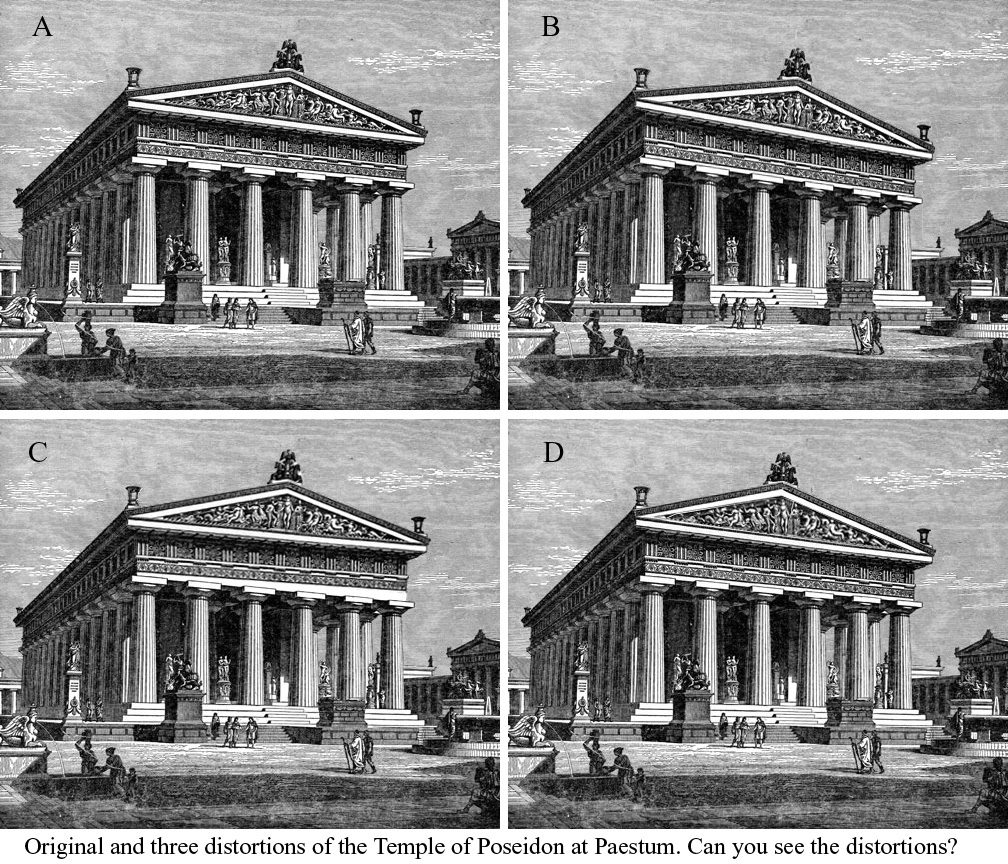 Take-home assignment based on the preceding images:
Take-home assignment based on the preceding images:
Copy and print the following test
sheet.
Name_________________
This is a test of your sensitivity to
appearances vs. realities, both of actual (depicted) form and of beauty of
form. Return the completed test sheet in class Thursday, October 7 or
e-mail it to me by midnight Saturday, October 9.
a. Can you see the differences of depicted
form in images A-D? Which deformations of architectural form do you see? Be
specific -- and careful.
__________________________________________________
__________________________________________________
b. Can you see any differences of beauty
among A-D? Try to rank the four versions of the temple in point of beauty.
Best________ 2nd best_______ 3rd best________
Worst ___________
Explain as best you can why you believe this
ranking is justified.
______________________________________________________________
c. When you detect an objective irregularity
does your impression of its beauty tank either immediately or after a short
time? Be specific. Comment below or on back of page.
______________________________________________________________
If you don't detect any objective difference
or difference of beauty, why do you think that is? And what does that
difficulty imply about the objectivity or subjectivity of beauty?
After the homework is handed in we will
exchange impressions.
_______________________________________________________________
19. An image, provided by NASA, I'm
told, was just sent to me by a colleague. It makes the point that our
perception is riddled with unbreakable illusions (just what Plato objected to
in it).
a. The original image
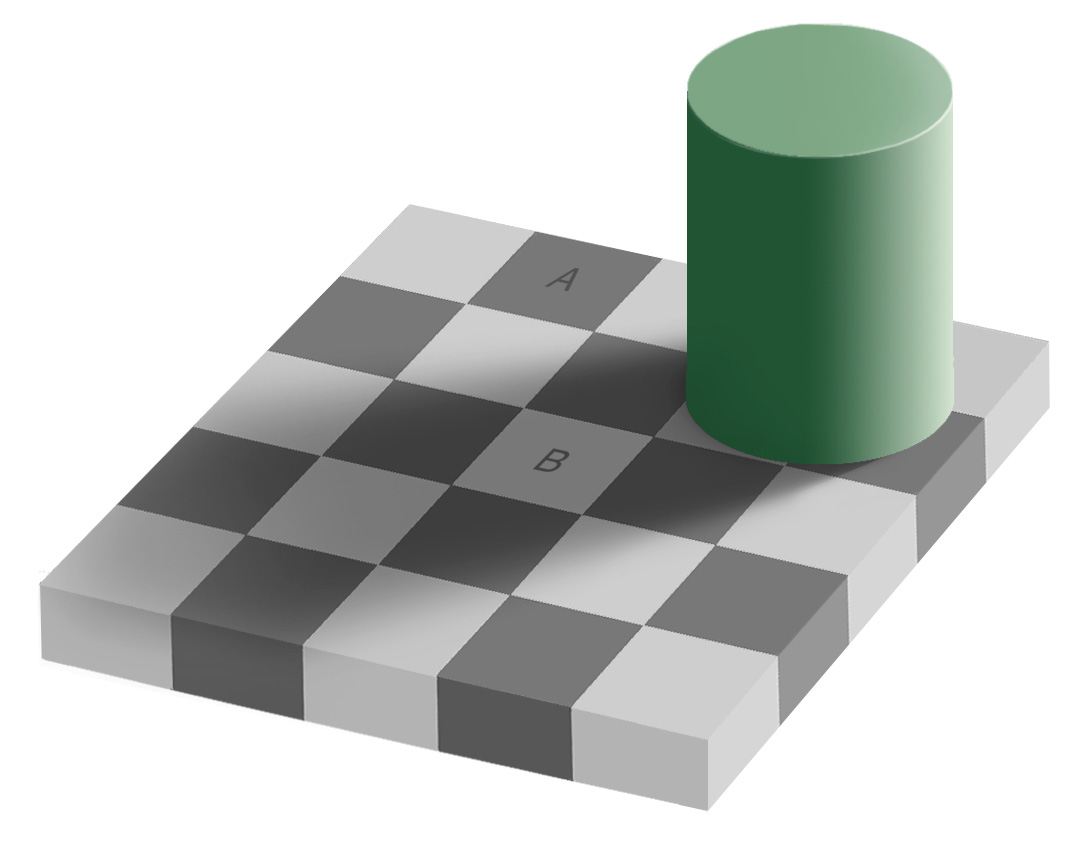
b. Proof of the illusion
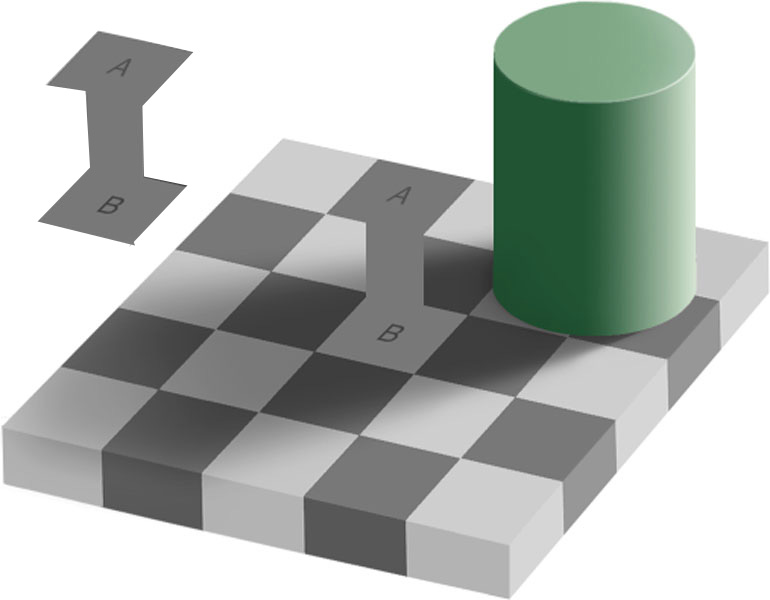
20. Great chain of being (Christian
version) illustrated.
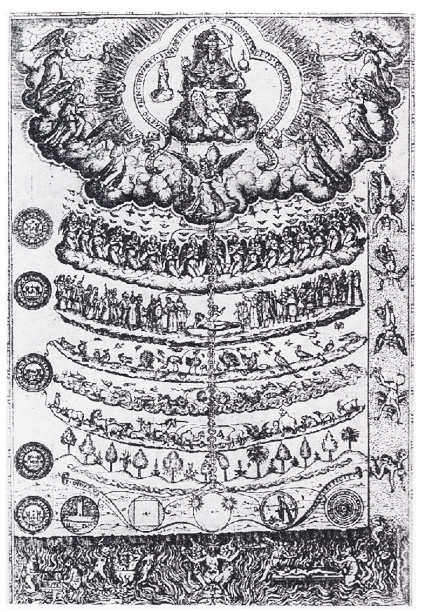
For further description of the ideas
reflected in this illustration, consult the Wikipedia article at: http://en.wikipedia.org/wiki/Great_chain_of_being
21. The aesthetic character of
athletic mastery.
R. Scott Kretchmar,
in "'Distancing': An Essay on Abstract Thinking in Sport
Performances," in Journal of the Philosophy of Sport (1982),
describes a state of mastery in sports that involves inventiveness and
spontaneity of variation that offers interesting parallels with descriptions of
aesthetic experience. By "abstract thinking" that "distances"
the athlete Kretchmar does not mean what Plato in the
one case, and Bullough in the other, mean. In spite
of his heavy terminology it turns out that he only means thinking of
possibilities beyond the established routines for dealing with a given sport situation.
The masterful athlete is creative in seizing opportunities on the fly, making
split-second decisions in varying her movements to achieve the goal (to keep
possession of the ball, to evade an opponent and get in position to shoot for a
goal, etc.) This requires a keen sense of the situation, the dispositions of
the opponent, etc., and also a large repertoire of tactics that have become
habitual, that can be done without any formal thinking. Armed with this the
athlete can often take the opponent by surprise. This doing of the unexpected,
the unusual, even the unthinkable or the never-having-been-done-before, belongs
to the essence of true mastery. It gives to mastery a sense of freedom and
sometimes of effortlessness that is a peak experience for the athlete.
I am quite convinced that athletic experience
is often beautifully masterful in what I take to be Kretchmar's
sense. Mastery at this level is a prime example of functional beauty. I find
confirmation in descriptions given by many close observers of prodigious
athletic feats. For instance, this one that appeared a couple of days ago about
Andy Irons, a superlative surfer who, the article said, "was admired for
an instinctive approach and singular style that blended Hawaiian elegance with
modern technical moves...'Andy would throw airs'— do aerial maneuvers —
'in the most improbable ways in the most unlikely parts of the wave,' Mr. Pezman said. 'When he was out, you
could hardly take your eyes off him, he was so radical. And he was totally
relaxed when he was in a big, grinding tube; when he was in jeopardy.'”

22. Amazing pendulum movements. Here is an URL for a demonstration of pendulum movement patterns that are worth appreciating for themselves and also instructive to compare with musically meaningful patterns.Pendulum Waves
The accompanying text lists the component waves: traveling waves, standing waves, beating, and random motion. The demonstration works best when NOT viewed full-screen but in the smaller format. Full-screen is too fuzzy.
23. George Bernard
Shaw on the pleasures of heaven and hell, Man and Superman, Act III.
